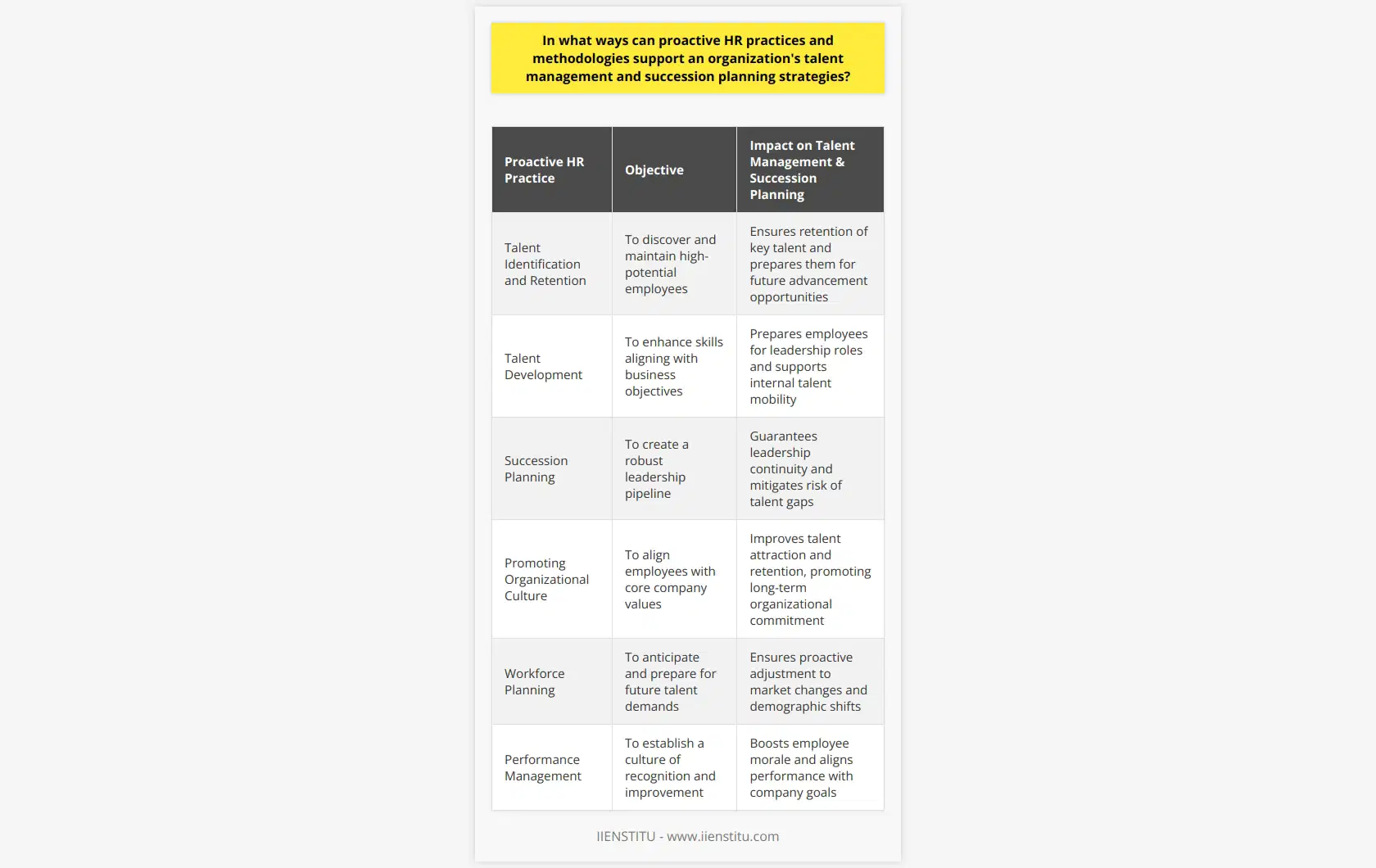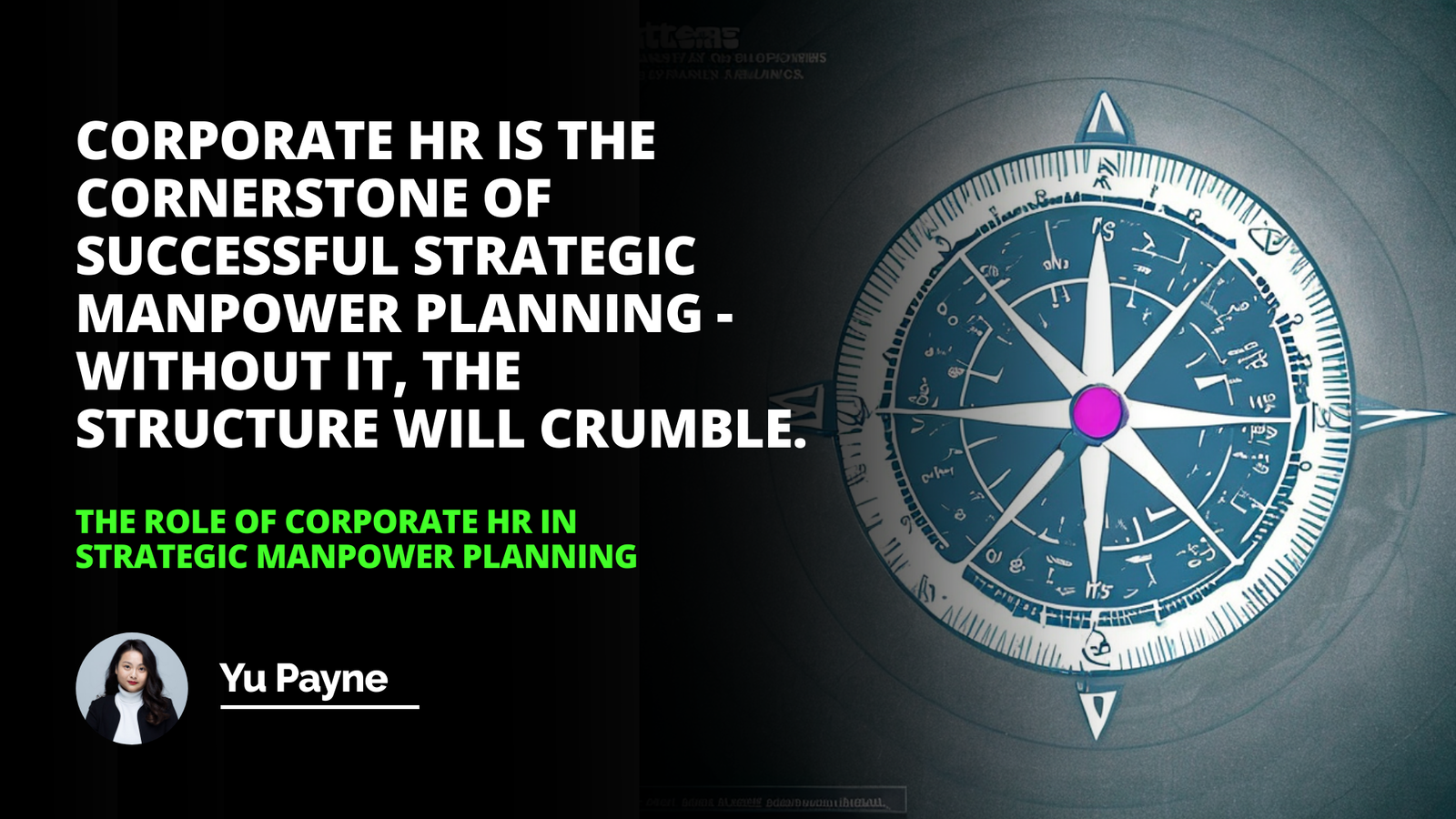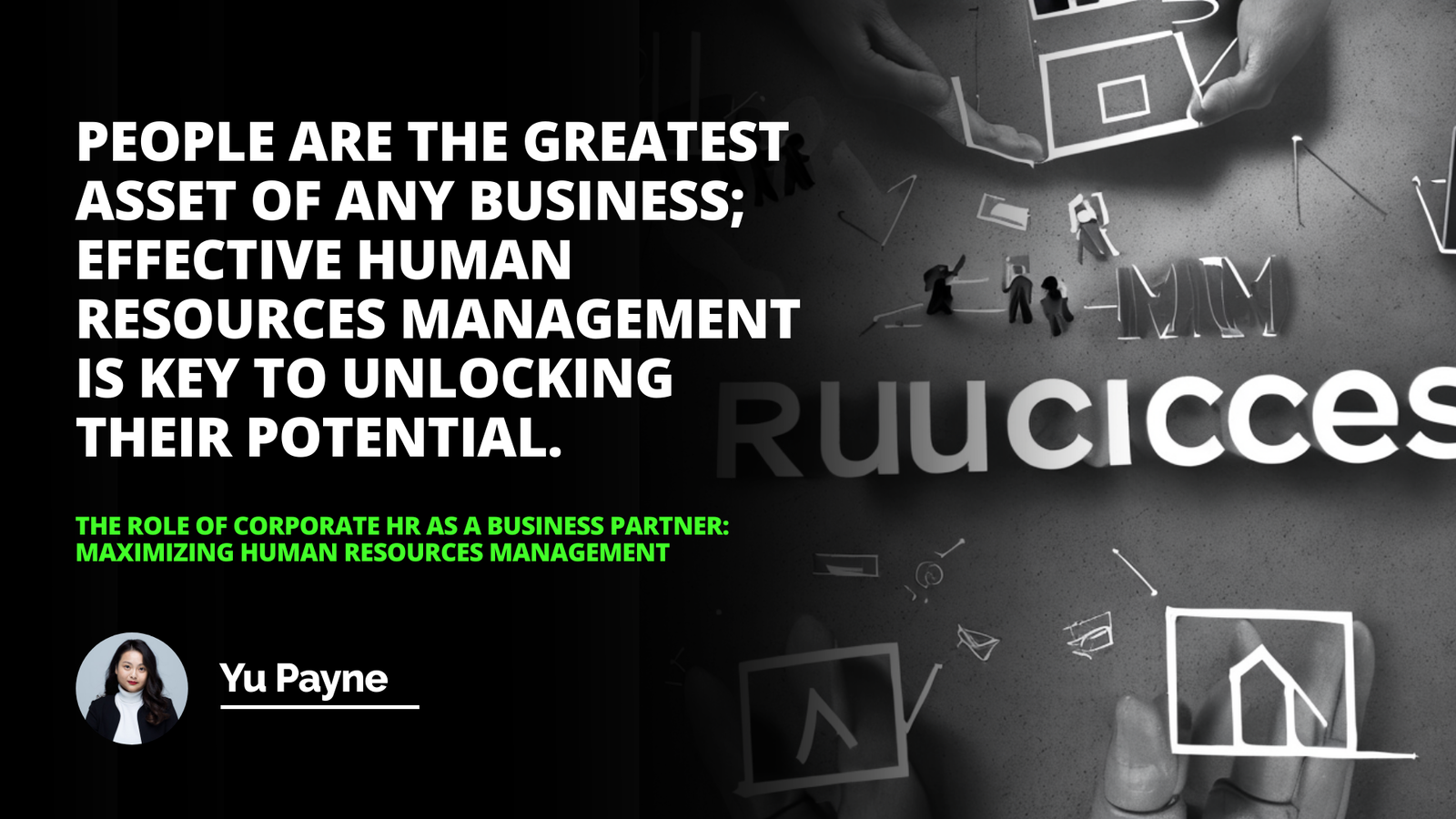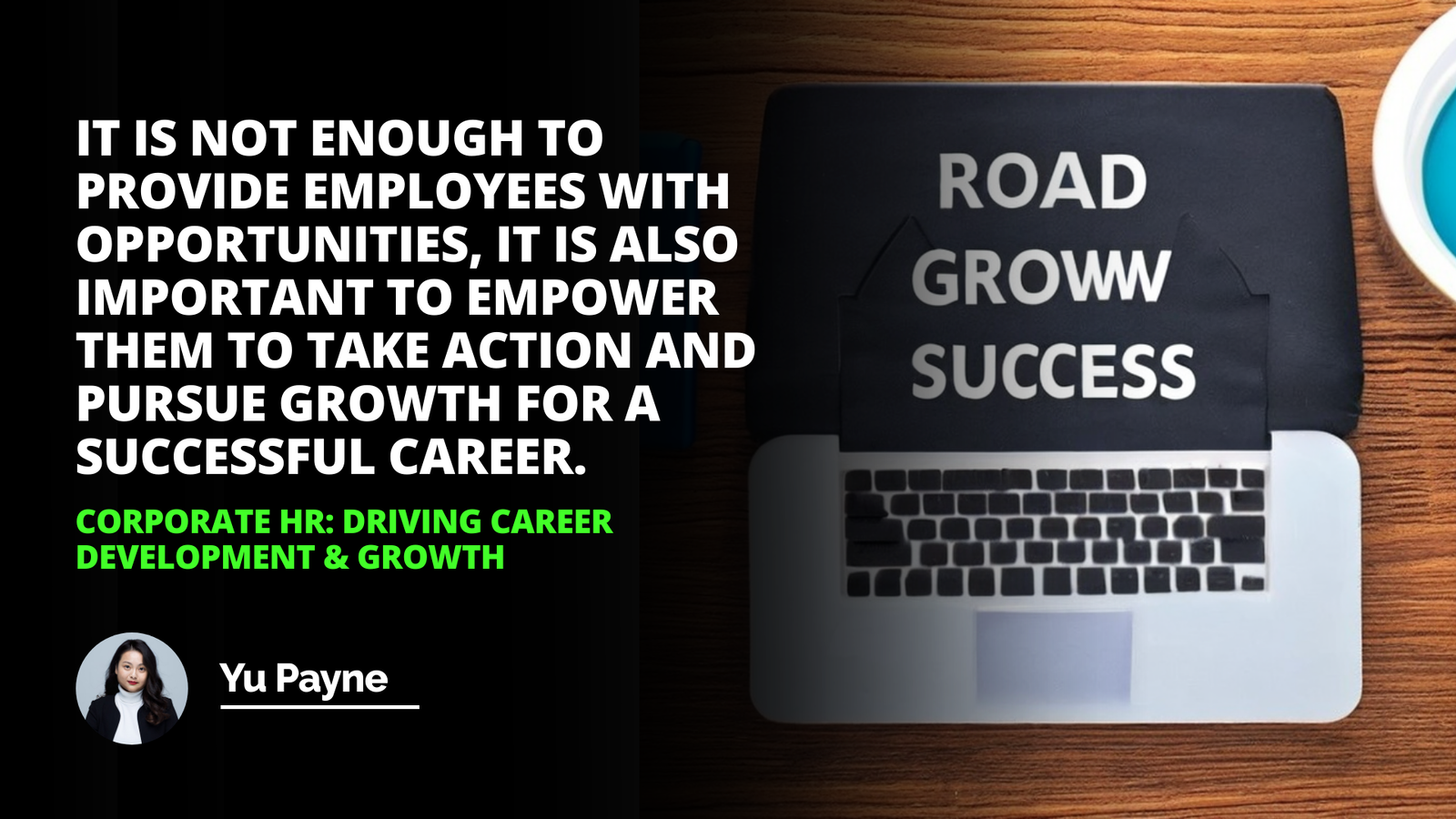
Human Resources is rapidly changing, and companies are beginning to understand the importance of instituting proactive corporate HR strategies. Employers must take affirmative steps in a highly competitive business landscape to ensure employees remain engaged, productive, and eager to tackle complex projects.
In this blog post, we'll explore the concept of proactive corporate HR, its importance to any business, and the better cards that successful strategies can reap.
What is Proactive Corporate HR?
Proactive corporate HR is setting goals and implementing strategies that enable a company to better and nurture its employees. This form of Human Resources strategy is different from traditional methods because it focuses on proactive strategies instead of reactive ones. An aggressive HR strategy involves the creation of an environment where employees feel valued and respected. It also entails introducing policies and incentives that boost employee engagement and encourage job satisfaction.
The goals of Proactive HR vary depending on the company's objectives. Generally, the primary purpose is to ensure that the company remains attractive to top talent by staying ahead of the competition regarding employee engagement. Additionally, it involves giving employees a greater sense of job security and a higher quality of life. The core beliefs of proactive HR are that successful employee engagement and satisfaction equate to improved business performance and long-term sustainability.
The Benefits of Proactive Corporate HR
The primary benefits of using a proactive corporate HR strategy are improved employee engagement and enhanced business performance. Studies have shown that employees are more motivated and productive when they feel their efforts are recognized and rewarded. Furthermore, when staff is provided with the appropriate learning and development opportunities, they can improve their skill sets and further contribute to the organization's success.
Enhanced employee engagement can also lead to improved customer satisfaction. A happy workforce is more likely to interact positively with customers and is more likely to improve the customer experience. Additionally, by maintaining a positive workplace, companies can turn over and retain top talent, increasing competitive advantage.
Examples of Proactive Corporate HR Practices
An effective recruitment process is one of the most important tools for fostering a dynamic and productive environment. Companies should strive to identify talented candidates who fit seamlessly into the organization's culture. Additionally, they should use progressive interview techniques such as behavioral assessments to ensure they find the best employees for the job.
Employee training is also an essential part of any proactive HR strategy. Companies can use various methods to educate their employees, including seminars, workshops, and e-learning platforms. They should also consider offering a variety of incentives to motivate employees to learn new skills and advance in their professions.
Overall, implementing a proactive corporate HR strategy can benefit any business. When done correctly, these strategies can improve employee engagement, enhance business performance, and reduce employee turnover. Additionally, when employees are given the tools and support to succeed, they tend to be more motivated and productive, improving customer satisfaction. For companies looking to reap the rewards of proactive corporate HR, the key is to identify key characteristics of success and implement strategies that will have the most impact.
By proactively embracing change in Human Resources, businesses can reap the rewards of improved performance and reduced costs.
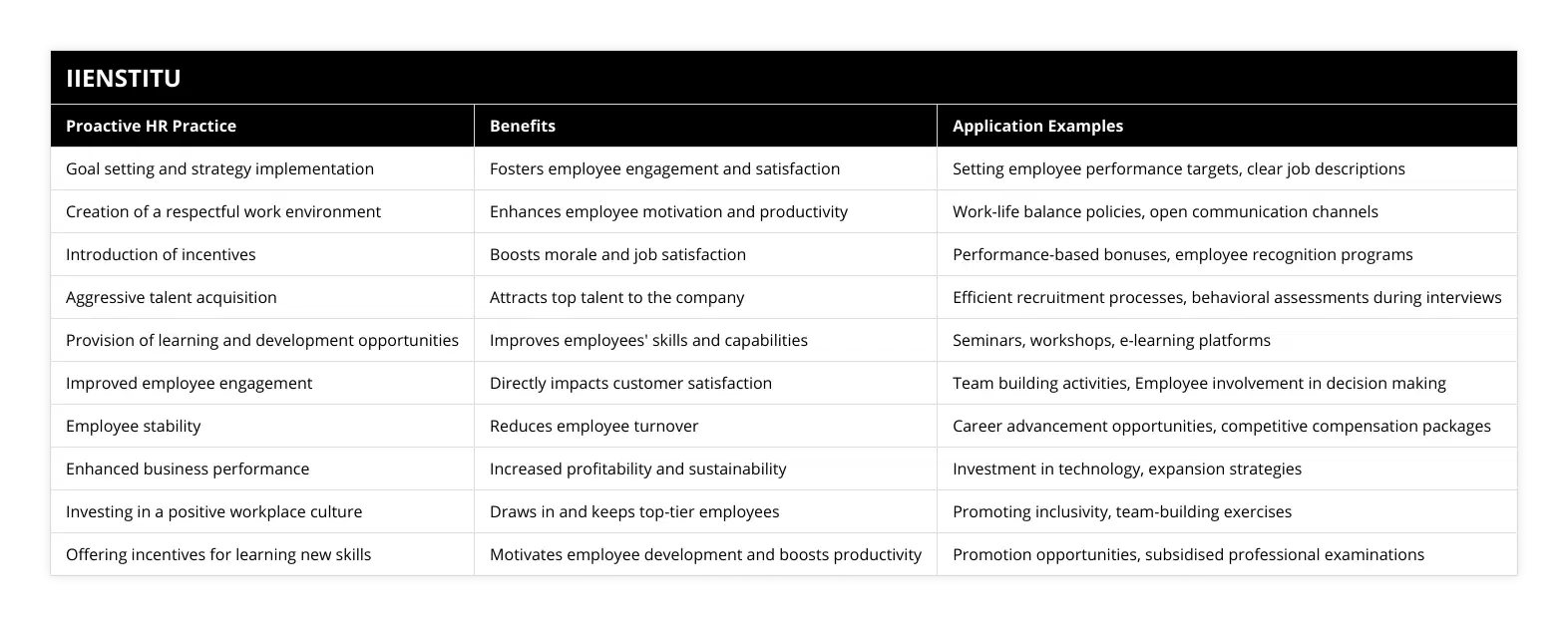
Frequently Asked Questions
What methods can human resource departments use to proactively capitalize on corporate opportunities?
Employing proactive strategies can be a powerful weapon for human resource departments when striving to capitalize on corporate opportunities. Such aggressive techniques may utilize workforce alignment, best practice utilization, and diversity and inclusion.
Organizations can benefit from workforce alignment of the knowledge and skills in their human resource department with the organization's needs. This helps ensure that employees, processes, and systems align with the organization's ambitions. In addition, by understanding a company's goals and how best to support their achievement, human resources can better position themselves and the organization to take advantage of opportunities.
Best practice models offer an ideal way of presenting various corporate challenges. Many existing organizational challenges can be solved using best-practice models first developed elsewhere. Human resource professionals should be familiar with and seek to identify the problem-solving approaches of the most successful firms and learn how to apply them to the corporate challenges their organizations encounter.
Diversity and inclusion (D&I) have been identified as powerful tools for capitalizing on corporate opportunities. By establishing a more inclusive talent strategy, organizations can better leverage the skills and experiences of candidates from diverse backgrounds. Organizations can also benefit from understanding demographic shifts within their workforce that can affect productivity, such as generational shifts. Further, best practices have indicated that diversity within your human resources department can positively impact performance.
Human resource professionals must be proactive when working to capitalize on corporate opportunities. Engaging in workforce alignment, utilizing best practices, and implementing diversity and inclusion strategies can position your organization to take advantage of potential opportunities. Conversely, companies that do not actively pose themselves for success may miss out on chances for advancement.
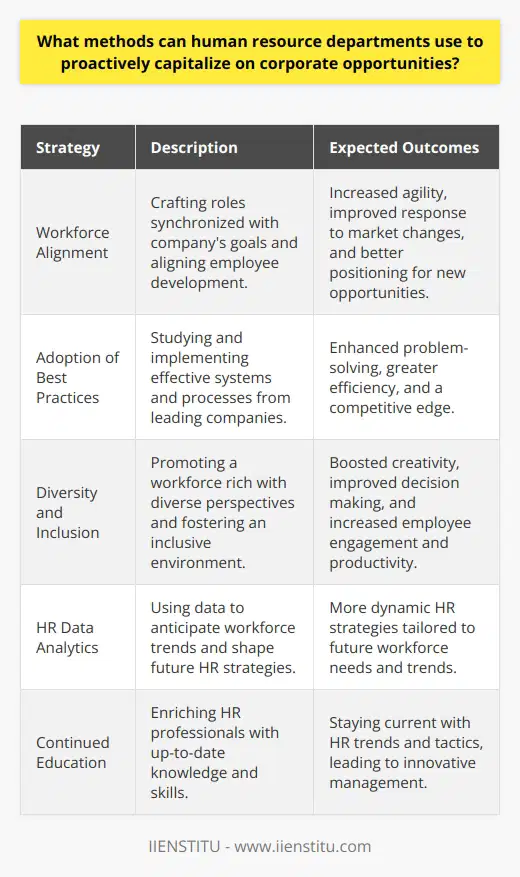
How do developing a corporate culture of proactive HR benefit the organization as a whole?
Organizations seeking to develop a corporate culture of proactive Human Resources (HR) can reap numerous benefits regarding cost savings and higher productivity. A proactive approach to HR supports a strategy aimed at cost avoidance and value creation. In addition, this strategy focuses on anticipating and addressing organizational needs and opportunities in an integrated and holistic manner with an eye toward long-term continuity and resilience.
Organizations that employ proactive HR tactics seek to increase efficiency through attentive forecasting and planning. By proactively examining and anticipating the type of labor required, organizations can maintain and develop a better understanding of their labor supply and modify their labor practices to capitalize on those resources. CompaIn addition, companies plan and respond quickly to changing market conditions, such as a downturn in business or the influx of new staff. As such, a good HR strategy helps ensure that any operational changes within the organization can occur efficiently and cost-effectively.
Proactive HR also looks to maintain and improve employee morale. A greater focus on employee wellbeing and satisfaction, such as by providing flexible working conditions and better upskilling, helps to ensure that staff feels appreciated in their current roles. Staff who feel satisfied with their job tend to be more productive and less likely to leave the organization. As such, the proactive HR strategy helps to promote employee retention, resulting in fewer costs associated with recruiting and training new staff.
Developing a corporate culture of proactive HR is also beneficial to the workplace environment in terms of improving relationships between staff and management. By focusing on the well-being of employees and recognizing the organization's needs, a positive feedback loop is created that creates a safe and secure work environment where everyone can thrive. Moreover, proactively focusing on the development and promotion of employees can lead to higher morale, greater engagement, and enhanced pride in the organization's performance.
In summary, organizations seeking to develop a corporate culture of proactive HR can enjoy numerous benefits spanning the entire organization. This includes cost savings, improved productivity, and a healthier workplace environment. As such, organizations must know the many advantages that proactive HR can bring and work to integrate it into their organization's culture.
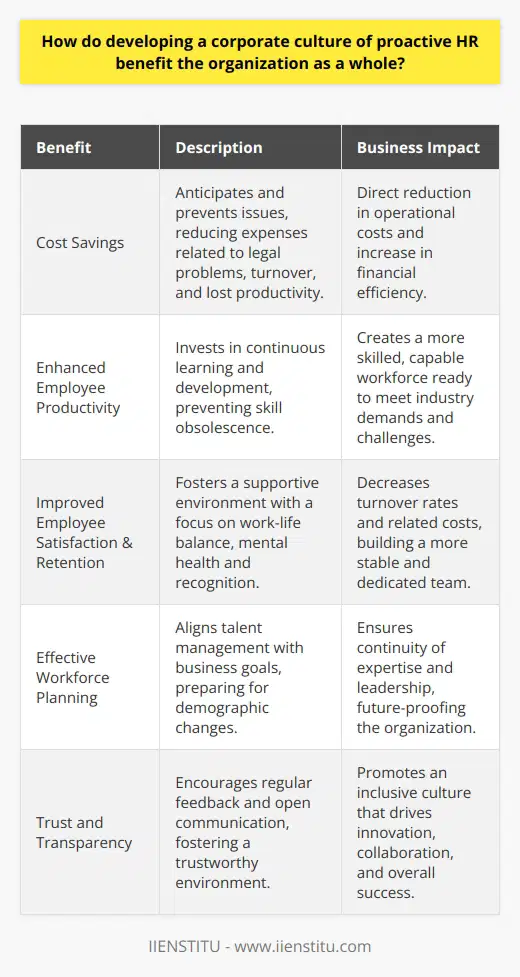
What strategies can be implemented to develop the skills and culture of a proactive HR department?
In the past two decades, there has been increasing emphasis on the role of Human Resource (HR) departments in successfully running organizations. To ensure that organizations remain competitive and successful, HR departments must be proactive in developing their departments' skills and culture. This article discusses the various strategies that can be implemented to achieve this goal.
The first step in developing a proactive HR department is ensuring all staff members have the appropriate training and experience. This can be achieved through traditional methods such as classroom learning, e-learning modules, and on-the-job experience. Each of these methods should be tailored to the department's needs and designed to improve the knowledge and skills of all employees. Regular reviews and appraisals should also be undertaken to ensure that all employees are on track and that any potential weaknesses are identified and addressed.
In addition to training, creating an environment where employees feel supported can also be beneficial in developing a proactive HR department. This can be achieved by providing employees with mentorship opportunities, access to professional development resources, and regular performance feedback. In addition, encouraging open communication between management and staff assists in ensuring that employees feel their opinions are valued and helps create a collaborative culture.
The development of a proactive HR department is also dependent on effective leadership. Leaders should be focused on developing employees' knowledge and skill sets, willing to take risks, and open to new ideas. Furthermore, leaders should be aware of the latest HR trends and have an open-door policy to encourage communication with staff members.
Finally, a proactive HR department should commit to continuous learning and development. This can be achieved by allowing employees to attend industry training and conferences, setting up a regular lunch-and-learn program, or allowing employees to attend seminars and workshops to stay abreast of changes in the industry. Additionally, the department should be proactive in setting up regular social events for employees, such as barbecues, team-building activities, and picnics, so that staff can network and build relationships.
In conclusion, the success of a proactive HR department will depend on the implementation of innovative strategies. The above process will help ensure that the department's skills and culture are developed effectively and that employees can work together in an environment that supports creativity and collaboration.
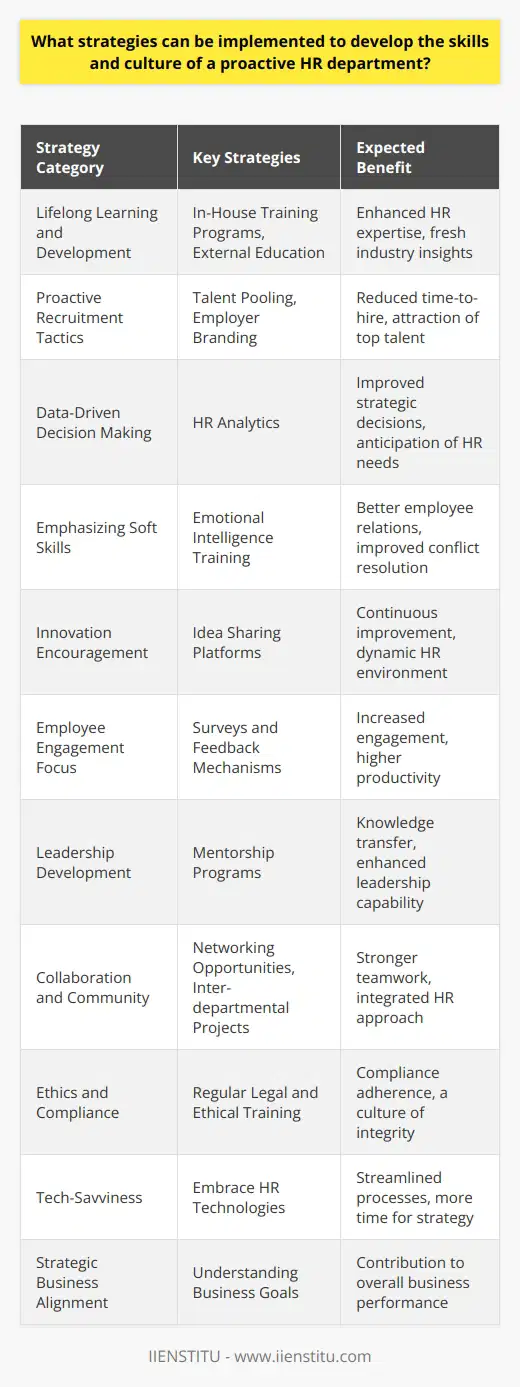
What are the key differences between reactive and proactive mechanisms in HR policies?
Key Differences
The distinction between reactive and proactive mechanisms in human resource (HR) policies primarily rests on the approach taken to address workforce-related issues. Reactive mechanisms involve responding to situations as they occur, while proactive measures focus on anticipating and preventing potential problems before they arise.
Reactive Mechanisms
Reactive HR mechanisms often come into play when organizations address existing issues or grievances, such as employee dissatisfaction or workplace conflicts. These measures tend to be implemented on an ad hoc basis, wherein the HR department intervenes and resolves specific concerns as needed. Examples include dealing with employee complaints, handling cases of harassment, and mediating disputes among team members. Although reactive mechanisms can help resolve immediate problems, they might not be the most effective approach for avoiding recurring issues.
Proactive Mechanisms
On the other hand, proactive HR policies seek to establish measures that prevent problems before they emerge. By anticipating potential challenges and implementing strategic solutions, organizations can mitigate risks and foster a more stable work environment. Examples of proactive mechanisms include implementing regular employee engagement surveys, building comprehensive training plans, and developing a robust succession plan to ensure leadership continuity.
Benefits of Proactivity
A proactive HR policy benefits organizations in various ways, such as increased employee satisfaction, higher retention rates, and a more positive work culture. By investing in problem prevention, organizations can reduce the likelihood of employee disengagement and promote a sense of ownership among staff members. This proactive approach ultimately contributes to a more supportive and cohesive work environment, which is conducive to increased productivity and long-term success.
In conclusion, reactive mechanisms in HR policies address issues on an as-needed basis, while proactive approaches involve strategizing to deter potential problems. By investing in proactive HR measures, organizations can create a more positive work culture, fostering higher employee morale, and promoting overall organizational success.
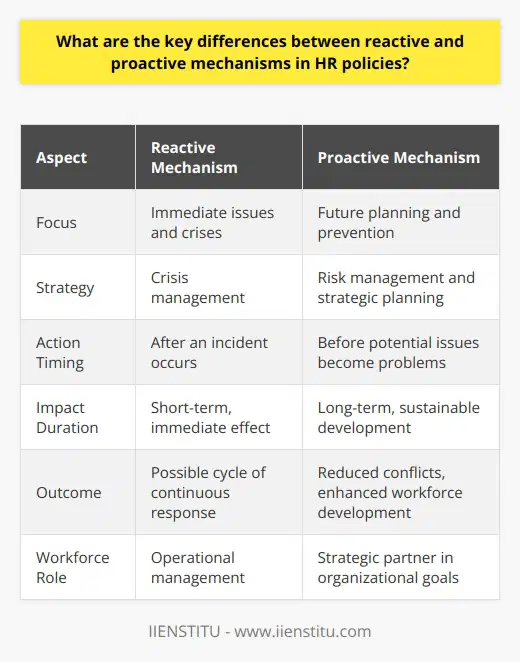
How do the four human resource strategies contribute to the overall success of an organization?
**HR Strategies and Organizational Success**
Effective human resource (HR) strategies play a crucial role in an organization's overall success by aiding the achievement of strategic goals, enhancing employee satisfaction, and promoting growth. Four essential HR strategies contribute to the accomplishment of these objectives.
**Talent Acquisition and Management**
Talent acquisition and management encompass the process of identifying positions needed within an organization, as well as attracting, recruiting, and retaining skilled employees. This strategy ensures that the organization has the appropriate talent pool to support its objectives and cultivate a motivated and engaged workforce. With the right people in the right roles, the organization can maintain a competitive edge.
**Training and Development**
Investing in employee training and development fosters growth not only for individual employees but also for the organization as a whole. Equipping employees with the necessary skills and knowledge enables them to excel in their roles and drive the organization towards success. Moreover, continuous learning ensures the organization can adapt to dynamic market conditions by maintaining an adaptable and knowledgeable workforce.
**Performance Management**
A well-structured performance management system allows organizations to monitor employee progress, provide regular feedback, and establish clear performance expectations. By aligning individual goals with organizational objectives, employees understand how their efforts contribute to the organization's success. Regular assessment and feedback can also help identify areas requiring improvement, enabling timely adjustments needed to achieve optimal performance.
**Employee Engagement and Welfare**
Prioritizing employee engagement and welfare fosters a positive work environment, which is vital for attracting and retaining top talent. Implementing proactive measures such as work-life balance initiatives, career mobility options, recognition programs, and wellness initiatives can lead to higher job satisfaction and morale. Engaged and satisfied employees are more likely to contribute positively to the organization's growth and success, and ultimately, to its long-term health and sustainability.
In conclusion, the four human resource strategies - talent acquisition and management, training and development, performance management, and employee engagement and welfare - contribute significantly to an organization's overall success. By investing in these strategies, businesses can ensure a skilled, motivated, and satisfied workforce capable of driving growth, achieving strategic goals, and maintaining a competitive edge in the market.
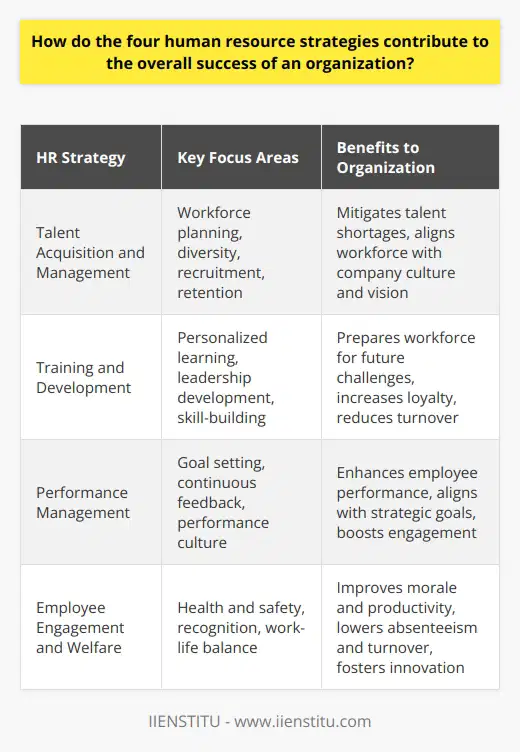
Can you explain the process of transitioning from a reactive approach to a proactive approach in HR?
Understanding Reactive and Proactive Approaches
To effectively explain the process of transitioning from a reactive approach to a proactive approach in HR, it is crucial to first understand the core differences between these two strategies. The reactive approach often involves resolving problems and dealing with consequences that have already occurred, while the proactive approach focuses on preventing potential issues and developing strategies in advance.
Establishing a Proactive Culture
The first step in transitioning from a reactive to proactive HR approach is to establish a proactive culture within the organization. This involves fostering a forward-thinking mindset among employees and emphasizing the importance of anticipating challenges before they arise. Encourage open communication, sharing of ideas, and a sense of collective responsibility to facilitate early detection and prevention of potential problems.
Developing Plans and Strategies
In a proactive HR approach, strategic planning is of utmost importance. HR teams must actively develop plans and strategies that address various aspects of the organization, including talent management, employee engagement, and skill development. These plans should outline clear objectives, timelines, and measures for success, empowering the HR team to anticipate future needs and take purposeful action to achieve desired outcomes.
Data-Driven Decision Making
Implementing data-driven decision making is a critical aspect of transitioning to a proactive HR approach. Utilizing HR analytics enables organizations to identify trends, assess risks, and make more informed decisions. Analyzing data allows HR teams to pinpoint areas requiring attention and develop targeted strategies to address specific concerns, thus driving continuous improvement and preventing potential issues from arising.
Regular Review and Evaluation
Finally, adopting a proactive HR approach involves continuous review and evaluation of HR processes and initiatives. This ensures that HR strategies remain effective and relevant, taking into account both internal and external factors that may impact the organization. Regular assessment allows for proactive adjustments when necessary, preventing potential issues and optimizing overall HR performance.
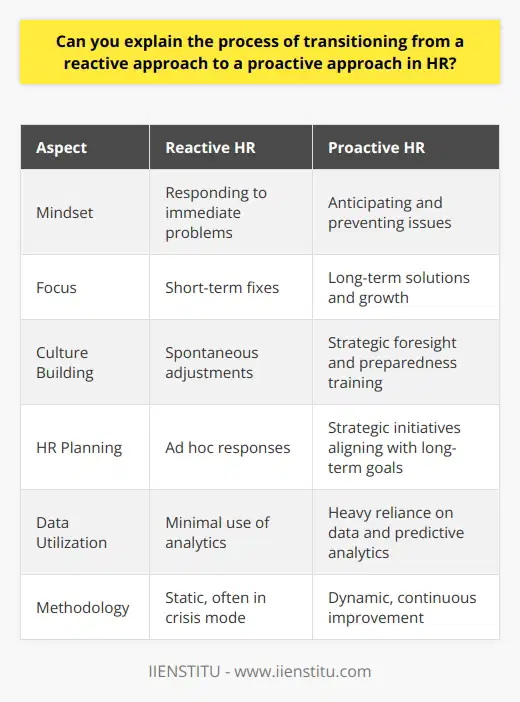
What is the significance of balancing reactive and proactive human resource management in an organization?
The Balancing Act
The significance of balancing reactive and proactive human resource management in an organization lies in their complementary nature, which ensures smooth operations and sustainable growth. By combining both approaches, companies can effectively address current issues while anticipating and preparing for future challenges.
Reactive Human Resource Management
Reactive human resource management refers to the organization's immediate response to employee-related issues and concerns, such as managing conflicts, resolving performance problems, and implementing policy changes. This approach is essential in maintaining a stable work environment and effectively managing day-to-day operations.
Benefits of Reactive HRM
Conflict Resolution: Promptly addressing interpersonal or operational disparities maintains a harmonious work atmosphere, fostering productivity.
Legal Compliance: Ensuring adherence to labor laws and regulations protects organizations from potential litigation, safeguarding their reputation and resources.
Job Satisfaction: Effectively addressing employee frustrations and needs contributes to a positive workplace experience, increasing employee retention.
Proactive Human Resource Management
Proactive human resource management focuses on strategically shaping organizational culture, aligning business goals with personnel management practices such as recruitment, training, and employee empowerment. This approach enables organizations to anticipate challenges and embrace change, thereby driving continuous improvement and enterprise-wide success.
Benefits of Proactive HRM
Talent Acquisition: By building strong employer brands, organizations can proactively attract top-tier talent, elevating their competitive advantage.
Workforce Development: Investing in employee training and development instills a growth mindset, cultivating a pool of skilled and adaptable personnel.
Organizational Agility: Cultivating an adaptive and forward-thinking work culture enables companies to swiftly respond to shifting market demands or unfavorable disruptions.
Conclusion
In conclusion, the integration of reactive and proactive human resource management empowers organizations to navigate both immediate and long-term concerns effectively. By proactively shaping workplace culture and strategically responding to evolving employee needs, companies can foster employee satisfaction, maintain legal compliance, and drive sustainable business growth.
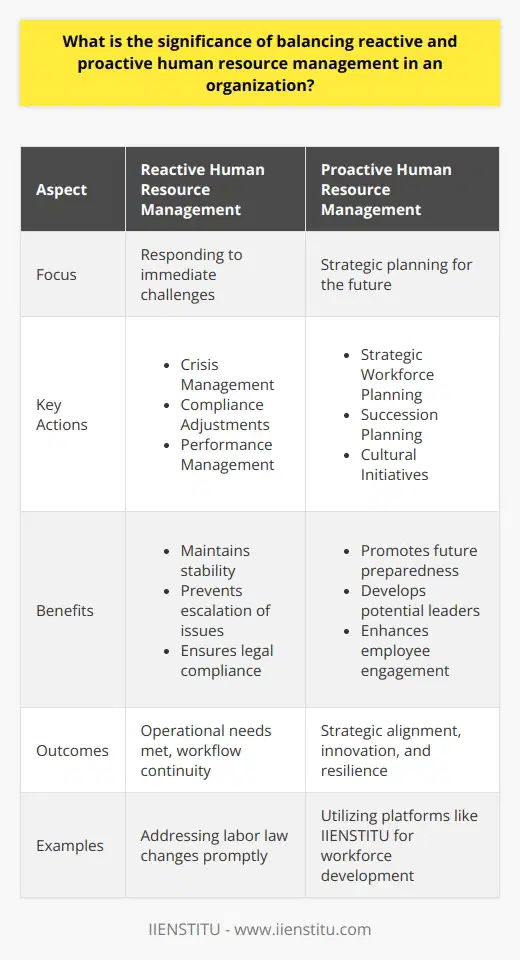
How do the four human resource strategies work in tandem to promote a proactive HR culture?
Aligning HR Strategies
In fostering a proactive HR culture, the four human resource strategies - recruitment and selection, training and development, performance management, and compensation and benefits - must be cohesively integrated to enhance overall organizational performance. Each HR strategy has a unique role, but they work synergistically to promote a proactive, employee-oriented culture and achieve organizational objectives.
Recruitment and Selection
To begin with, implementing a robust recruitment and selection strategy ensures an organization attracts a diverse, high-quality workforce. By focusing on the acquisition of skilled, motivated, and aligned talent, HR departments are better poised to foster a proactive culture bound by a shared commitment to the organization's vision and values.
Training and Development
Equally important is the provision of ongoing training and development programs, enabling employees to further their skills and capabilities throughout their tenure. Investing in employees' growth is essential to cultivate a culture of continuous improvement, as it equips them with the necessary tools and resources to adapt to changes, take on new challenges, and contribute effectively.
Performance Management
Performance management is another indispensable HR strategy, serving to evaluate employee contributions and align them with organizational goals. By setting clear expectations and providing regular feedback, a proactive HR culture is nurtured, as employees are encouraged to not only meet objectives but to actively seek opportunities to excel in their roles.
Compensation and Benefits
Finally, a well-designed compensation and benefits structure plays a vital role in promoting a proactive HR culture. By offering competitive remuneration packages and a range of meaningful incentives and rewards, organizations can motivate employees to be engaged, committed, and performance-driven.
In conclusion, the integration of these four human resource strategies is paramount in cultivating a proactive HR culture. Each strategy's alignment with organizational goals, coupled with a strong commitment to employee well-being and growth, serves as the foundation for building an engaged, high-performing workforce capable of adapting and flourishing in the face of change.
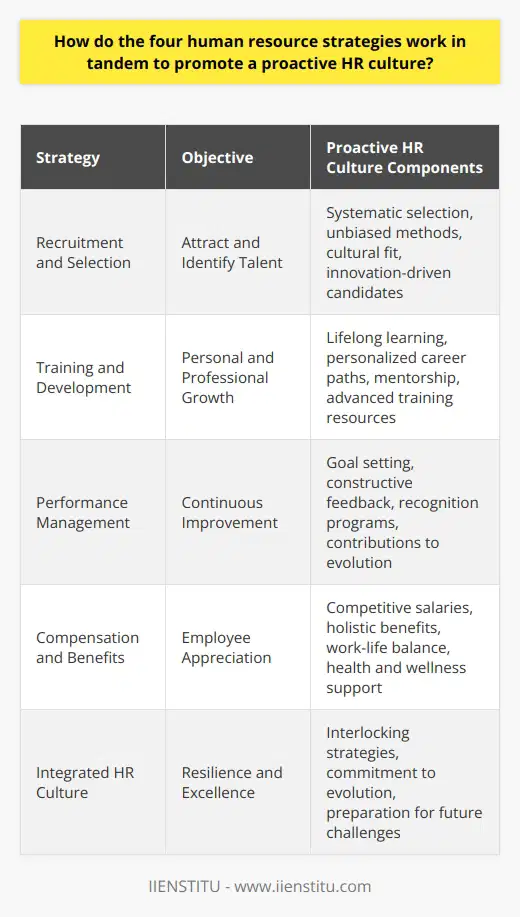
In what ways can organizations measure the effectiveness of a proactive HR approach in their human resource management?
Assessing Proactive HR Approaches
Organizations can measure the effectiveness of a proactive HR (human resources) approach in various ways, ranging from employee satisfaction to retention rates. In doing so, they can determine if their HR initiatives are contributing positively to overall business success.
Employee Satisfaction
One crucial way to measure effectiveness is through employee satisfaction surveys. By regularly evaluating and tracking employees' perspectives, organizations can gain valuable insights into the impact of HR policies and programs. A satisfied workforce often indicates that proactive HR strategies are addressing employees' needs and challenges.
Retention Rates
Another measurable aspect of HR effectiveness is retention rates. A high employee retention rate suggests that the HR department's initiatives are successful at identifying and retaining valuable talent. On the other hand, a low retention rate may indicate that proactive HR efforts require improvement.
Training Program Outcomes
Evaluating the outcomes of training programs can also provide valuable insights into the success of a proactive HR approach. Organizations can assess whether employees have acquired new skills and knowledge or improved their performance as a result of training interventions. Moreover, tracking the return on investment (ROI) for training initiatives can help determine if they are worth the resources expended.
Recruitment Metrics
Besides retention rates, analyzing recruitment metrics, such as the number of applications received, the quality of candidates, and the duration of the hiring process, can help measure the effectiveness of proactive HR strategies. Efficient recruitment processes can support an organization's growth and influence its competitiveness in the market.
Employee Engagement
Lastly, evaluating employee engagement can be a useful indicator of effective HR practices. An engaged workforce is typically more productive and committed to their organization's success. Regularly assessing employee engagement levels can guide organizations in refining and expanding their HR initiatives to maintain a highly motivated workforce.
In conclusion, organizations can measure the effectiveness of their proactive HR approaches through several avenues, including employee satisfaction, retention rates, training program outcomes, recruitment metrics, and employee engagement. Regularly assessing and analyzing these indicators can contribute to informed decision-making and ultimately, drive business success.
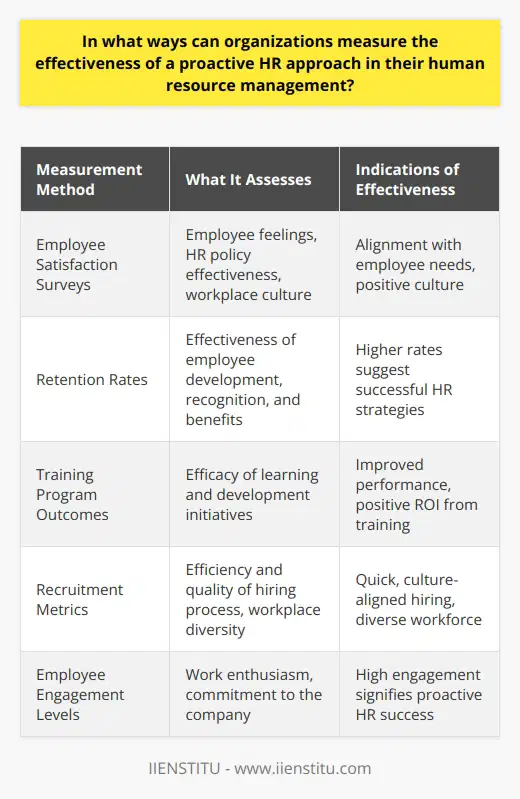
What is the role of technology in facilitating a proactive approach in HR?
Role of Technology in HR Practices
The role of technology in HR is pivotal, as it enables the department to adopt proactive approaches in managing employees and organizational processes. One such instance is the utilization of HR analytics. By analyzing data on employee performance, skill sets, and demographics, HR teams can identify trends and gain insights that inform workforce planning and talent management. This data-driven approach allows HR professionals to anticipate and address potential personnel challenges before they escalate, fostering a more productive and compliant work environment.
Facilitating Communication and Collaboration
Another aspect where technology plays a key role is in enabling seamless communication and collaboration between HR and employees. Platforms such as intranets, instant messaging, and video conferencing foster agility and responsiveness, essential for proactively addressing employee concerns and queries. This two-way communication fosters transparency, engagement, and trust, strengthening the overall employee experience and enhancing retention rates.
Automating HR Processes
Automation is yet another technological advancement that reinforces proactive HR practices. Tools such as applicant tracking systems (ATS), learning management systems (LMS), and performance management platforms assist in streamlining various HR processes. By reducing the burden of repetitive and time-consuming tasks, HR professionals can focus more on strategic planning and continuous improvement of employee programs.
Enhancing Employee Training and Development
In addition to process automation, technology facilitates effective employee training and development through e-learning platforms, virtual reality, and augmented reality. This access to advanced learning tools allows employees to continuously develop their skills and knowledge, promoting a culture of continuous learning. HR professionals can thus proactively respond to changes in the job market and emerging skill requirements, ensuring their workforce remains competent and competitive.
Supporting Remote Work and Flexibility
Lastly, given the growing trend of remote work, technology affords HR the necessary infrastructure to support flexible work arrangements. By leveraging cloud-based systems, organizations can establish secure access to files, tools, and data, enabling employees to work efficiently from various locations. This flexibility not only promotes employee satisfaction and retention but also allows HR to access a larger talent pool when recruiting.
In conclusion, technology serves as an enabler of proactive approaches in HR, ultimately driving efficiency, adaptability, and competitive advantage for the organization. By leveraging data analytics, communication tools, automation, and e-learning platforms, HR professionals can strategically address workforce challenges and foster a thriving work environment.
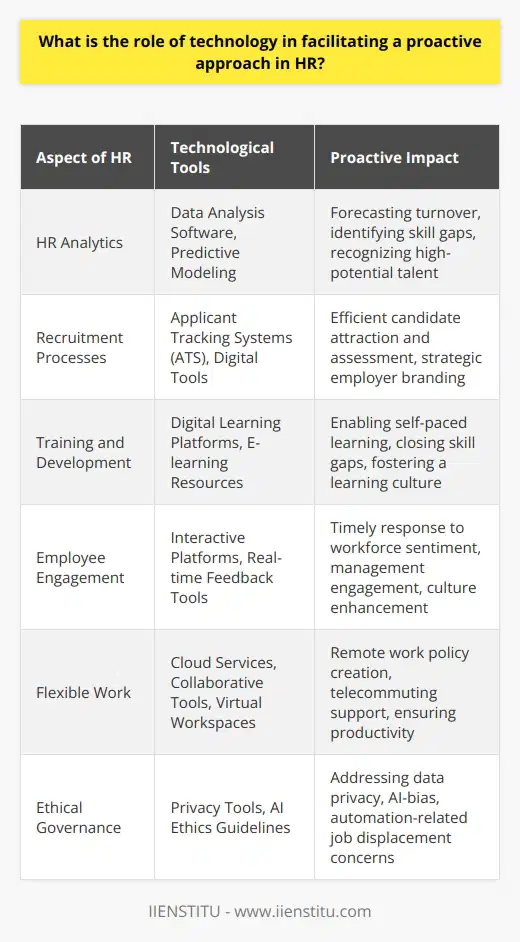
How does a proactive HR strategy contribute to employee engagement, satisfaction, and retention?
HR Strategy and Employee Engagement
A proactive HR strategy plays a crucial role in fostering employee engagement by designing initiatives tailored to employees' needs, interests, and strengths. This approach not only ensures a positive work environment but also creates a sense of belonging and purpose among employees. As a result, they are more likely to be committed to their organization's goals and demonstrate high levels of work performance.
Promoting Employee Satisfaction
The implementation of proactive HR strategies can have a significant impact on employee satisfaction, as it focuses on the well-being and development of employees. By offering targeted training and development opportunities, HR professionals empower employees to grow both personally and professionally. Aligning these opportunities with employee aspirations further demonstrates an organization's commitment to their success, leading to higher job satisfaction.
Employee Retention and Proactive HR
Moreover, a proactive HR strategy plays a vital role in employee retention by addressing the factors that contribute to turnover. Regular employee feedback and open communication channels can aid HR professionals in identifying the underlying issues and taking appropriate steps to resolve them. Recognizing and rewarding employees for their contributions also fosters appreciation and loyalty, making them more likely to remain with their current employer.
Supporting Organizational Growth
In conclusion, the adoption of a proactive HR strategy contributes to better employee engagement, satisfaction, and retention by effectively addressing employee needs and aspirations. In turn, this approach leads to a more loyal, productive, and motivated workforce that ultimately supports the organization's growth and success. By investing in proactive HR strategies, businesses are laying the foundation for a strong, sustainable competitive advantage built on the commitment and capabilities of their employees.
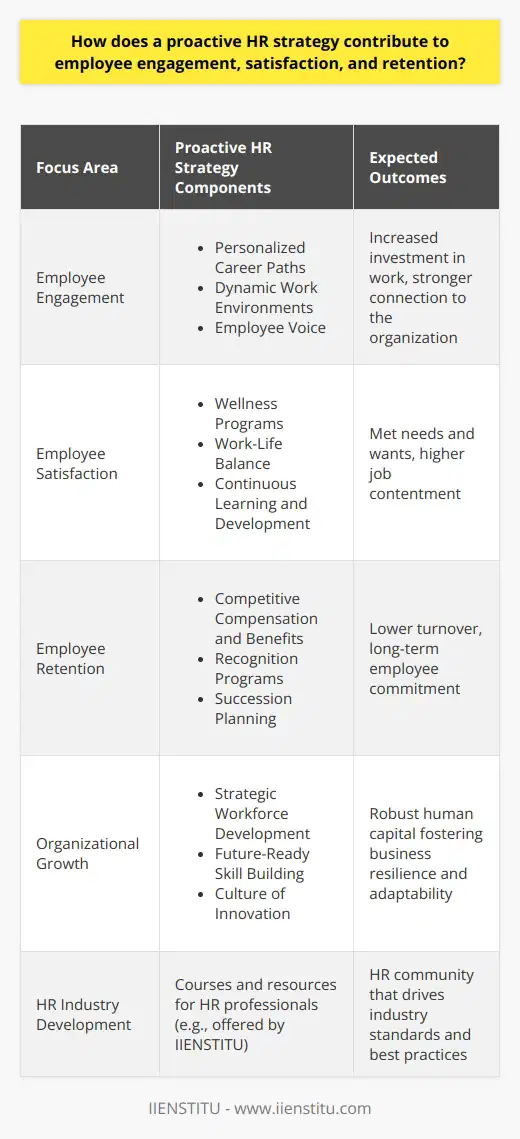
In what ways can proactive HR policies improve diversity and inclusion within an organization?
Factors Contributing to Enhanced Diversity and Inclusion
Proactive HR policies, when implemented effectively, can significantly improve diversity and inclusion in an organization. A key factor is transparent communication. HR departments should clearly express their commitment to fostering diverse and inclusive work environments and encouraging employees to voice their concerns and share their experiences. Engaging discussions and inclusive decision-making can lead to more equitable policies and practices.
Targeted Recruitment and Retention Strategies
Another essential aspect is investing in targeted recruitment and retention strategies. HR departments need to broaden their talent pools by actively seeking out and engaging underrepresented groups. This includes crafting inclusive job descriptions, implementing unbiased candidate evaluation methods, and offering competitive benefits packages designed to support employees across demographics. Additionally, HR professionals can facilitate employee mentorship and development opportunities, ensuring long-term professional growth and success for a diverse workforce.
Inclusive Work Culture
Furthermore, developing an inclusive work culture is vital for diversity and inclusion initiatives to take root. HR departments should implement various strategies, such as offering diversity and bias training programs, providing regular feedback on employee progress, and establishing diversity and inclusion councils. These councils can help identify the specific needs and challenges of underrepresented employees, suggesting necessary improvements to organizational policies and practices, and thereby fostering a more inclusive work environment.
Centralizing Employee Information and Monitoring Progress
Lastly, by centralizing employee information and closely monitoring progress, HR professionals can better assess the effectiveness of their diversity and inclusion policies. Collecting comprehensive demographic data helps identify gaps in representation and opportunities for improvement. HR teams should frequently review and update these policies and practices to ensure they remain relevant, effective, and in line with legal regulations.
In conclusion, proactive HR policies can improve diversity and inclusion within an organization through strategies such as transparent communication, targeted recruitment and retention efforts, cultivating an inclusive work culture, and continuously monitoring progress. Thus, HR professionals play a crucial role in fostering diverse and inclusive work environments, which ultimately benefits the organization as a whole.
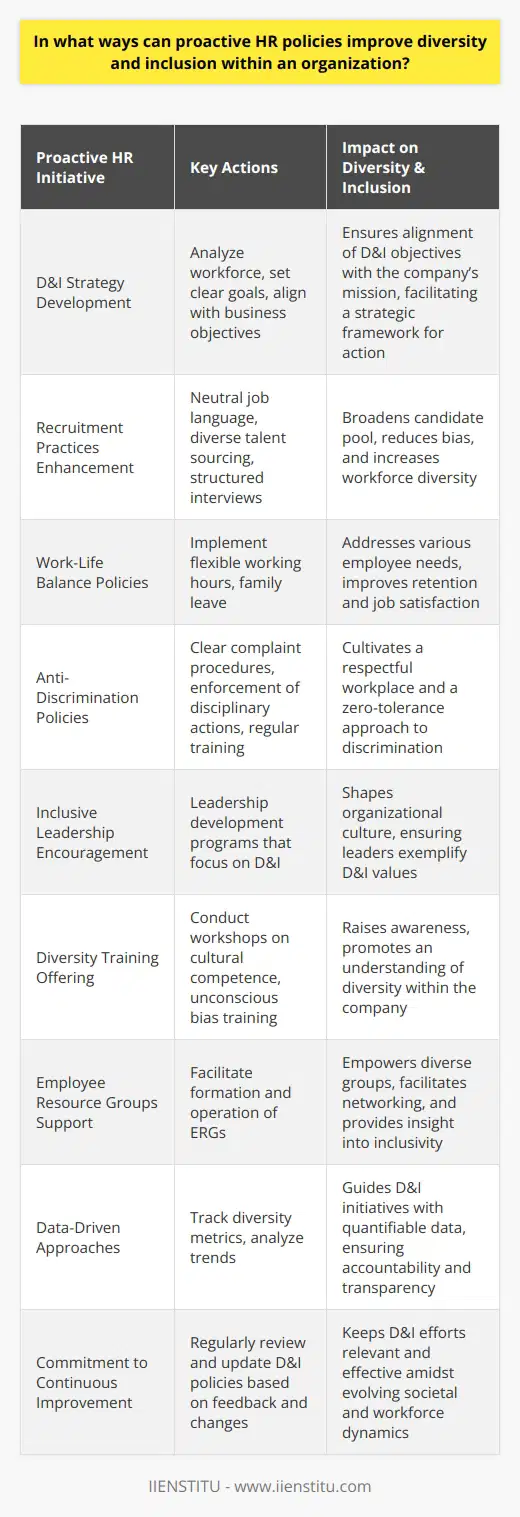
What are the key components and characteristics of a proactive human resource management approach?
Proactive HRM Approach: Key Components and Characteristics
The proactive human resource management (HRM) approach is essential for modern organizations to stay competitive in the constantly changing business landscape. This approach requires companies to anticipate and address future workforce challenges strategically, rather than reacting only when issues arise. The key components and characteristics of a proactive HRM approach include workforce planning, competency development, employee engagement, and continuous improvement.
Workforce Planning
Workforce planning is a cornerstone of proactive HRM, as it requires organizations to forecast their future workforce needs, understand existing gaps, and develop strategies to close these gaps. By linking human resources planning to overall business strategy, proactive HRM ensures that companies have the right talent in place, at the right time, to meet their objectives.
Competency Development
Proactive HRM emphasizes the importance of developing the skills and capabilities of employees to meet present and future demands. This requires organizations to identify the competencies needed for key roles, assess current capabilities, and plan targeted training and development initiatives. Competency development is essential for retaining high-potential employees, achieving business goals, and maintaining a competitive edge in the market.
Employee Engagement
Engaging employees is crucial to the success of a proactive HRM approach. High levels of engagement lead to increased productivity, improved retention, and strong alignment with organizational values. To foster engagement, proactive HRM involves creating a supportive work environment, offering meaningful opportunities for personal and professional growth, and providing clear communication channels to ensure employees understand their essential role in achieving organizational goals.
Continuous Improvement
Finally, proactive HRM embraces the concept of continuous improvement, with a focus on constantly refining policies, practices, and processes to stay ahead of industry trends. By regularly evaluating the effectiveness of HR initiatives, organizations can adapt their strategies to meet changing workforce needs more effectively. Continuous improvement requires HR leaders to remain informed about latest industry developments, adopt innovative approaches, and embrace a culture of growth and learning throughout the organization.
In conclusion, a proactive HRM approach is vital for organizations to anticipate and proactively address future workforce challenges, ensuring their continued growth and competitiveness. Key components of proactive HRM include workforce planning, competency development, employee engagement, and continuous improvement, all of which contribute to the strategic and timely management of a company's most valuable asset - its human capital.
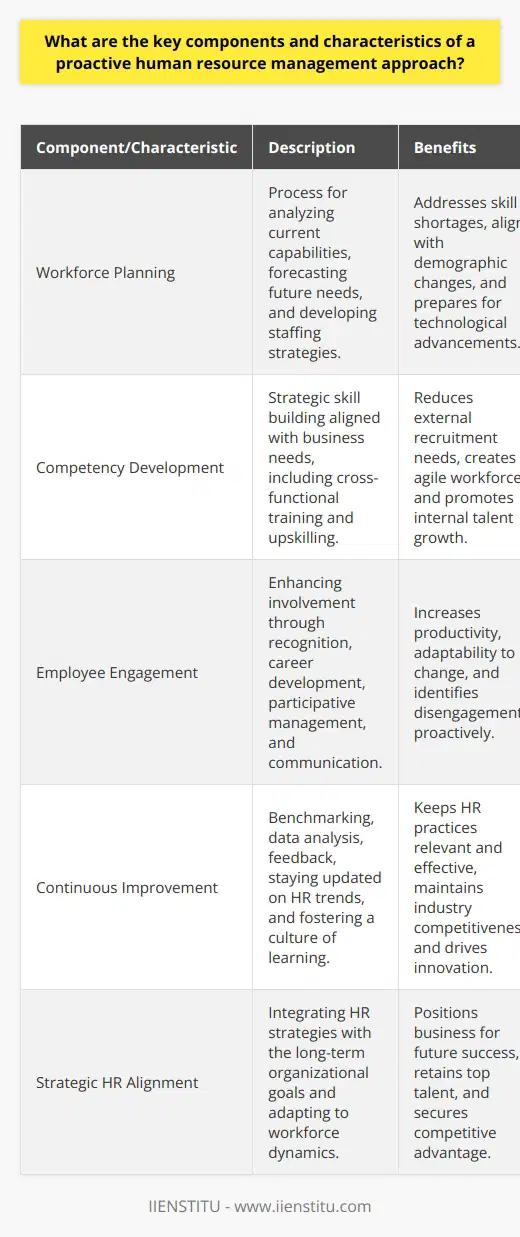
How does proactive HR contribute to long-term organizational growth and sustainability?
Proactive HR and Organizational Growth
A proactive Human Resources (HR) approach significantly contributes to an organization's long-term growth and sustainability. By anticipating future needs and challenges, HR can implement strategic initiatives that promote a robust workforce, fueling the continuous growth and progress of an organization.
Talent Acquisition and Retention
One vital aspect of proactive HR is adopting a forward-thinking approach to talent acquisition and retention. By identifying workforce trends, gaps, and skill requirements, HR professionals can recruit suitable candidates to fill necessary positions and develop strategic retention plans for existing employees. This builds a more competent and loyal workforce, ultimately enhancing organizational growth and sustainability.
Employee Training and Development
A key focus of proactive HR lies in continuous employee training and development. This enhances the knowledge, skills, and abilities of the workforce, enabling them to tackle new challenges, acquire advanced competencies, and adapt to evolving business landscapes. Consequently, investing in employee development directly correlates with long-term organizational growth and success.
Workforce Planning and Adaptability
Proactive HR also helps organizations remain agile and adaptable in a rapidly-changing business environment. Workforce planning and analysis allow HR professionals to evaluate employee performance, assess staffing needs, and implement talent management initiatives. This proactive approach not only ensures that organizations have the right people with the right skills but also swiftly addresses emerging opportunities and threats in the market.
Creating an Inclusive Culture
Finally, proactive HR plays a crucial role in fostering an inclusive organizational culture that values diversity and equal opportunity. By promoting open communication, fairness, and psychological safety, HR professionals create a supportive work environment that helps retain employees and attract new talent. An inclusive culture plays a significant part in enhancing an organization's reputation, subsequently contributing to long-term growth and sustainability.
In conclusion, proactive HR is a vital instrument in ensuring the long-term growth and sustainability of an organization. Through strategic talent acquisition and retention, employee training and development, workforce planning and adaptability, and the creation of an inclusive culture, HR professionals can cultivate a motivated, skilled, and adaptable workforce, critical for navigating the challenges and seizing the opportunities of an ever-changing business environment.
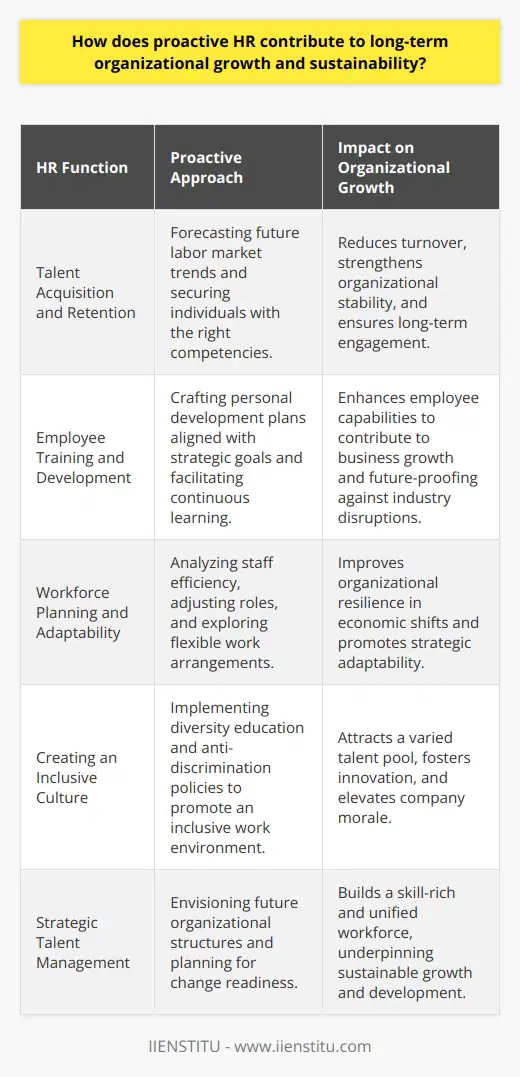
What role do analytics and data-driven decision-making play in implementing a proactive HR strategy?
Role of Analytics in Proactive HR Strategy
The Significance of Data-driven Decisions
Analytics and data-driven decision-making are crucial components in implementing a proactive Human Resources (HR) strategy. They enable organizations to identify trends, assess skill gaps, predict future workforce needs, and design targeted interventions for talent management. As a result, HR professionals can make informed, evidence-based decisions aimed at maximizing employee performance, engagement, and retention.
Workforce Planning and Talent Acquisition
In workforce planning, HR analytics allows identification of crucial roles, current employee competencies, and potential skill requirements. Analyzing this information helps predict future workforce needs and formulates strategies to address these demands. Consequently, organizations can engage in proactive talent acquisition, selecting and onboarding individuals with the knowledge, skills, and abilities critical to achieving long-term strategic objectives.
Performance Management and Skill Development
Data-driven insights offer valuable input for performance management, enabling managers to assess employee productivity and engagement objectively. Analyzing performance data helps identify performance patterns, strengths and weaknesses, and support requirements for individual employees. Armed with these insights, HR professionals can design targeted interventions, including coaching, mentorship, training, and support programs, aimed at promoting skill development, continuous improvement, and career growth.
Employee Retention and Succession Planning
Utilizing analytics, HR professionals can pinpoint factors affecting employee retention and dissatisfaction. By addressing identified issues proactively, organizations can foster a positive work environment, preventing attrition and maintaining productivity. Furthermore, HR analytics can inform the development of succession plans by identifying potential skills gaps and leadership pipeline limitations, allowing organizations to proactively prepare for future changes, minimizing talent shortages and leadership gaps.
Conclusion
In essence, the integration of analytics and data-driven decision-making into HR strategy fosters an anticipatory approach, enabling organizations to plan strategically for future workforce requirements, provide targeted support to enhance employee performance, and proactively mitigate risks related to retention and succession. These benefits underscore the critical role of data-driven practices in achieving long-term organizational success.
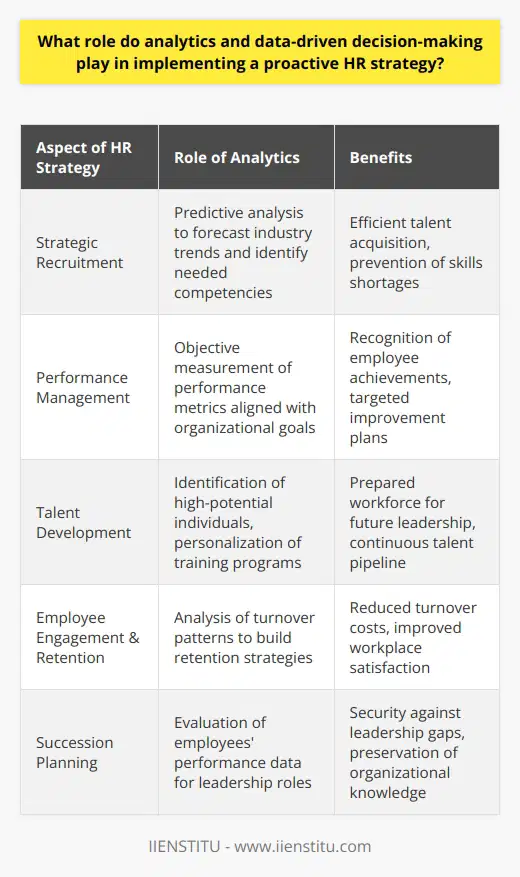
What is the role of leadership in fostering a proactive HR culture within an organization?
Role of Leadership in HR Culture
Effective leadership plays a vital role in fostering a proactive Human Resources (HR) culture within an organization. By actively promoting open communication, leaders help create an environment where employees feel comfortable discussing their needs, concerns, and aspirations. This openness encourages the HR department to proactively address employee matters and respond to workforce needs, including career development, performance management, and succession planning.
Influencing HR Strategy
Leaders also play a critical part in shaping the organization's HR strategy. By collaborating with HR professionals, they help align human resource practices with the company's business objectives, values, and goals. This alignment ensures the development of relevant initiatives that optimize employee satisfaction and productivity while increasing competitiveness and profitability. Additionally, leaders must promote the integration of HR into the organizational decision-making process to encourage a proactive and flexible HR culture.
Promoting a Diversity and Inclusion Culture
A proactive HR culture is one that values diversity and inclusion. Leaders must demonstrate their commitment to fostering an inclusive environment by modeling inclusive behaviors and challenging biases and unfair practices. By doing so, they send a clear message that the organization is committed to the fair and equal treatment of all employees. This not only improves employee engagement and job satisfaction but also helps the organization attract and retain top talent.
Encouraging Employee Development
Continuous employee development is a cornerstone of a proactive HR culture. Leaders must actively support employees in their growth by providing opportunities for skill development, training, and education. By offering these resources, leaders demonstrate that the organization values employee contributions and is invested in their long-term success. This focus on employee development not only promotes individual growth but also contributes to the overall success of the organization.
Driving Organizational Change
Leaders are critical agents of change within an organization. As such, they must demonstrate a willingness to embrace new ideas, processes, and technologies to better serve the workforce. By championing innovation and continuous improvement, leaders can influence HR to adopt proactive practices that anticipate and accommodate changing employee and organizational needs.
In conclusion, strong and effective leadership is crucial to fostering a proactive HR culture within an organization. By promoting open communication, collaboration, diversity and inclusion, employee development, and innovation, leaders help create an environment in which the HR department can proactively address employee needs, promote a positive workplace culture, and contribute to the overall success of the organization.
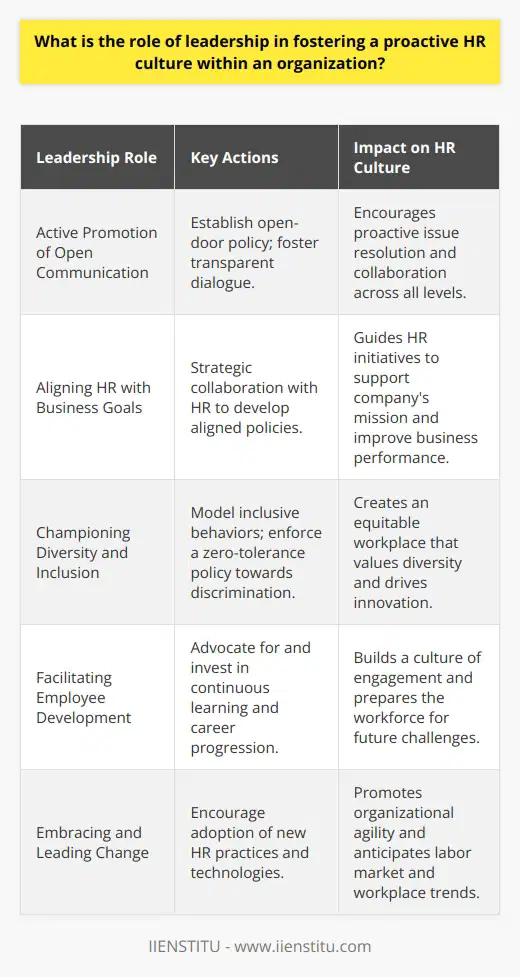
How can organizations create a balance between meeting short-term reactive HR needs and implementing long-term proactive HR strategies?
Creating a Balanced Approach
Organizations can strike a balance between addressing short-term reactive human resources (HR) needs and implementing long-term proactive HR strategies by adopting a holistic and integrated approach to workforce planning. This involves assessing the current workforce demographics, identifying future requirements, and developing effective strategies to bridge the gaps.
Workforce Assessment
The first step towards a balanced approach is to assess the current workforce in terms of its size, skills, experience, and demographic composition. This information can be obtained through HR audits and employee surveys, enabling the organization to understand its strengths and weaknesses and identify areas that require immediate attention.
Future Requirements Forecasting
In order to align HR efforts with long-term business objectives, organizations should engage in forecasting future workforce requirements. This involves analyzing various factors, such as market trends, technological advancements, and competition, which may impact the organization's future workforce needs. By anticipating these changes, organizations can develop adaptive HR strategies that provide flexibility to respond to changing business requirements.
Bridging the Gaps
Upon identifying the gaps between current workforce capabilities and future needs, organizations must design and implement initiatives that address both immediate and long-term HR needs. This may include recruitment, training and development, performance management, and employee retention programs. By strategically leveraging these initiatives, organizations can fulfill their short-term reactive HR needs while simultaneously building a pipeline of talent for the future.
Collaborative Decision-Making
Involving stakeholders from different departments in the HR planning process can help create an environment that fosters synchronization between short-term and long-term HR goals. This collaborative approach promotes shared ownership of HR initiatives and fosters alignment of HR strategies with business goals, allowing for a more effective balance between reactive and proactive measures.
Continuous Evaluation and Adaptation
Finally, organizations need to periodically evaluate the effectiveness of their HR strategies in meeting both short-term and long-term objectives. By collecting and analyzing relevant data, HR departments can identify areas of improvement and adapt their strategies accordingly to ensure that the workforce remains agile, skilled, and prepared for the future.
In conclusion, achieving a balance between meeting short-term reactive HR needs and implementing long-term proactive HR strategies requires an integrated approach that combines workforce assessment, forecasting, gap identification, collaborative decision-making, and continuous evaluation. By strategically aligning HR initiatives with business goals, organizations can effectively address both immediate and future workforce needs, ensuring sustainable growth and competitiveness.
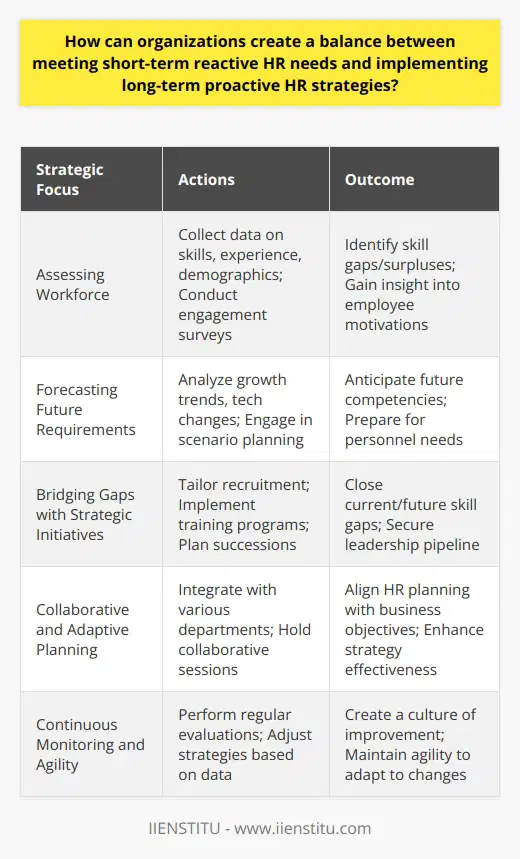
In what ways do proactive HR methodologies contribute to talent acquisition, development, and management?
Proactive HR Methodologies in Talent Acquisition
Proactive Human Resource (HR) methodologies play a crucial role in organizations' abilities to attract and acquire the best-suited candidates for specific roles. This is achieved through comprehensive job analysis, targeted job advertising, rigorous screening processes, and well-structured interviews that evaluate candidates not only for their technical expertise but also for their alignment with the organization's culture and values.
Role of Proactive HR in Talent Development
One of the key components of HR's proactive approach is the facilitation of talent development, which focuses on honing employees' skills and knowledge. By implementing an effective Learning and Development (L&D) strategy, organizations can provide targeted training programs, workshops, and mentoring opportunities. This ensures continuous improvement of employees and supports their career growth within the company. Moreover, by identifying high-potential employees and preparing them for leadership roles, HR can help facilitate succession planning, which is essential for maintaining sustainable growth and business continuity.
Significance of Proactive HR in Talent Management
Effective talent management encompasses a range of activities that involve assessing, nurturing, and retaining top talent within an organization. Proactive HR methodologies in talent management involve conducting regular performance reviews, creating individual development plans, and offering competitive compensation and benefits packages. By recognizing and rewarding high-performers, HR can boost employee engagement, satisfaction, and retention rates.
In conclusion, incorporating proactive HR methodologies is essential for organizations that are aiming to be competitive in today's rapidly evolving business landscape. By emphasizing talent acquisition, development, and management, HR can strengthen an organization's human capital, thereby ensuring sustainable growth and success.
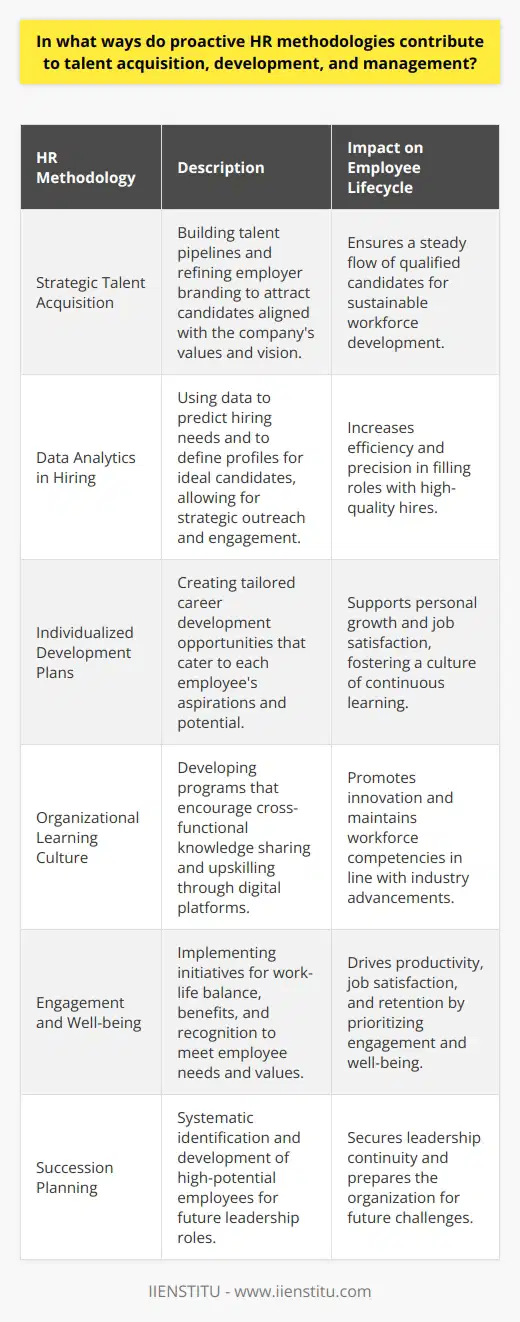
What are the key principles of proactive HR that enable organizations to better anticipate and respond to workforce challenges?
Understanding Proactive HR Principles
Proactive human resources (HR) focuses on 'anticipating' future challenges rather than simply 'reacting' to them. This approach requires extensive strategic planning and long-term vision. The significance of such approach is undeniable in maintaining workforce stability and effectiveness.
Analyzing HR Requirements
One key principle is continuously analyzing the organization's HR needs. This involves identifying the skills, knowledge, and capabilities that staff must possess to meet future organizational demands. This analysis measures the gap between current and future abilities, helping to plan for recruitment, training, or skill development.
Predictive Talent Management
Predictive talent management is another vital principle. It involves identifying individuals who have the potential to fill key leadership roles within the organization in the future. HR will plan career development strategies to ensure these individuals acquire the necessary skills and experience for succession planning.
Strategic Workforce Planning
Strategic workforce planning is essential in proactive HR. This approach analyzes the current workforce's strengths and weaknesses, predicts future labor requirements, and designs strategies to bridge the gap. It aims to ensure that the organization always has the right people in the right roles at the right time.
Creating an Agile Workforce
Creating an agile workforce is another key principle. HR must constantly update skills, knowledge, and abilities of employees to enable them to adapt rapidly to changing work environments. This could involve training programs, development initiatives, or providing opportunities for cross-functional roles.
Employee Engagement Strategy
Finally, implementing an effective employee engagement strategy is necessary. Engaging employees enables them to contribute optimally and ensures their alignment with organizational objectives. Engagement strategies can include reward programs, performance feedback systems, and channels for communication and participation.
In conclusion, proactive HR principles play a significant role in enabling organizations to anticipate and tackle workforce challenges more effectively. These principles help build a resilient organization ready to thrive amidst constant change.
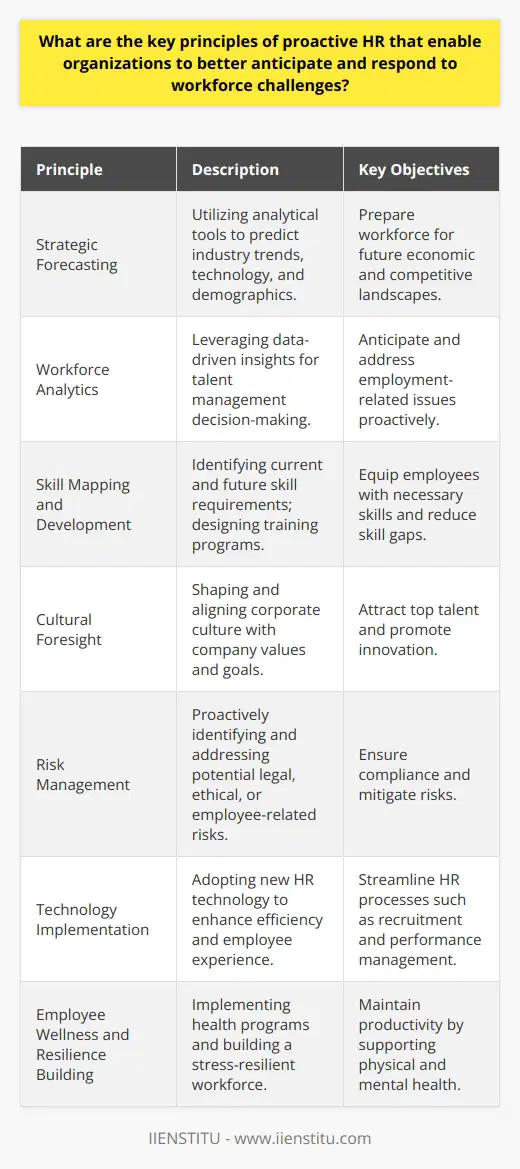
How can adopting a proactive approach in HR improve the efficiency and effectiveness of recruitment, selection, and onboarding processes?
Adopting Proactivity in Recruitment
A proactive approach in HR streamlines recruitment. By forecasting future workforce needs, businesses can secure top talent. Timely job postings and comprehensive role descriptions also attract more suitable candidates.
Efficiency in Selection
Efficiency in selection can be achieved through proactive strategies. Screening methods like psychometric tests improve the quality of shortlisted candidates, reducing the time spent on interviews. Regularly reviewing and updating selection criteria also ensures the process remains relevant.
Improving Onboarding through Proactivity
Onboarding benefits greatly from a proactive HR approach. By developing comprehensive and standardized onboarding processes, businesses ensure all new employees receive consistent training. This standardization cuts down on time wasted through inefficiency.
Maximizing Efficiency and Effectiveness
In conclusion, a proactive HR strategy enhances efficiency and effectiveness in recruitment, selection, and onboarding. By anticipating needs, utilizing efficient tools, and implementing standardized procedures, businesses can streamline their HR practices, resulting in a high-performing workforce.
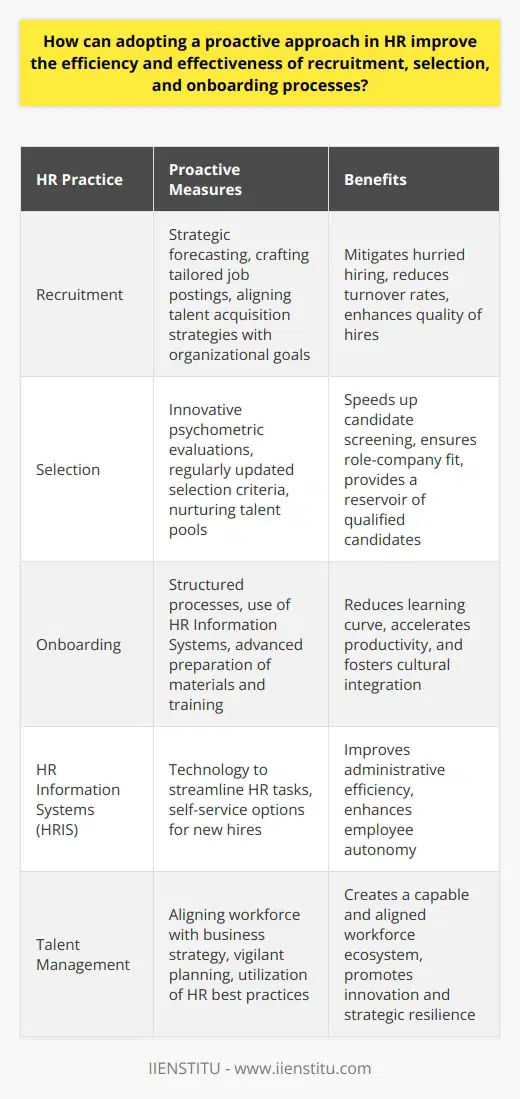
In what ways does a well-designed and executed HR strategy, encompassing the four pillars of HR, help organizations achieve competitive advantages in the marketplace?
HR Strategy Directly Linked to Market Success
A well-structured and executed Human Resources (HR) strategy assists organizations in acquiring competitive advantages. It focuses on improving key areas, effectively enveloping the four pillars of HR: recruitment, training, reward, and performance management.
Optimal Recruitment
Firstly, the strategic recruitment under HR plans allows companies to attract top talent. By creating an appealing employer brand and using effective selection methods, companies can gain an edge over their competitors. High-performing employees often drive an organization's competitiveness.
Effective Training and Development
Secondly, training and development programs impart necessary skills and improve workers' productivity. HR strategists identify skills gaps and develop comprehensive employee training plans. This enhances the company's collective expertise, promoting innovation, and fostering competitive advantage.
Meaningful Reward Structures
Thirdly, attractive compensation strategies can decrease turnover rates and increase employee motivation. By offering competitive pay and benefits, organizations can retain their top-performing staff. Additionally, rewarding employees for their performances often enhances their commitment and productivity.
Strategic Performance Management
Lastly, performance management helps determine employee contributions to company goals. Regular feedback and performance-related rewards can improve an employee's performance. This contributes to better overall operational efficiency, resulting in a competitive market position.
In summation, an effective HR strategy creates a quality workforce, driving competitive advantage. It fosters an environment of continuous improvement, innovation, and commitment. Thus, the role of HR extends beyond administrative functions, directly impacting an organization's competitiveness in the marketplace.
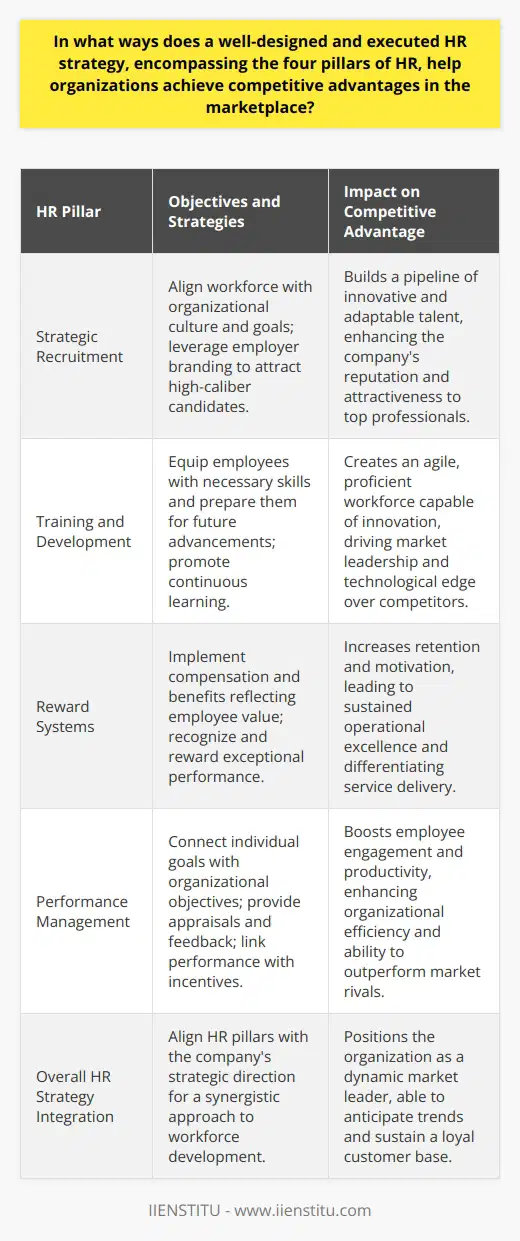
What are the essential steps for implementing a proactive human resource management strategy in an organization?
Establishing a Proactive HR Management Strategy
Defining Objectives
Implementing a proactive Human Resource (HR) management strategy first necessitates defining clear objectives. This involves aligning HR goals with the organization's strategic objectives, ensuring HR activities contribute to overall company success.
Conducting Analysis
Following this, thorough analysis of company's current HR practices is essential. This helps to identify any practices that need improvement, outdated systems, workplace gaps and skills shortages.
Adopting Predictive Analytics
Use of predictive analytics is a vital step. This tool analyzes historical data to forecast future requirements, promote proactive decision-making and develop strategies such as workforce planning.
Crafting Policies and Procedures
Crafting suitable policies and procedures comes next. Establishing specific performance metrics, attendance management protocols, diversity inclusion policies and training procedures are integral parts to cultivate a proactive HR environment.
Increasing Employee Engagement
Emphasizing employee engagement endorses proactive HR strategy. Active involvement in decision-making processes, reward mechanisms, communication channels, feedback loops, and training opportunities boost employee morale and productivity.
Emphasizing Continuous Learning
Lastly, nurturing a culture of continuous learning is key. This involves maintaining an ongoing training and development program to ensure employees possess the necessary skills to meet future workplace demands.
In conclusion, the implementation of a proactive HR strategy requires a significant commitment and collaboration from all organizational members. With clear objectives, comprehensive analysis, predictive analytics, effective policies, increased employee engagement, and continuous learning initiatives, organizations can establish an effective proactive HR management strategy.

How does proactive HR influence workforce planning and overall strategic business objectives?
Role of Proactive HR in Workforce Planning
Proactive Human Resources (HR) plays a significant role in workforce planning. It involves predicting future human capital needs, devising strategies to fulfill these needs, and aligning them with an organization's goals. This strategic approach ensures that the right quantity and quality of talent are available when needed.
HR practices such as talent sourcing, training, and development address potential skills shortages. This reduces the risk of business disruption due to inadequate staff or critical competencies. Proactive HR stays ahead of the curve, foreseeing challenges and planning requisite actions.
Link to Strategic Business Objectives
Furthermore, proactive HR contributes towards fulfilling strategic business objectives. Essential activity is aligning the workforce with the organizational strategic blueprint. For a strategic business objective to materialize, it requires company-wide coordination. Getting everyone on the same page is crucial.
For instance, if a company decides to focus on improving customer service, HR would recruit individuals with the necessary skills. HR lines up training programs to sharpen these skills. Policies get enacted that incentivize excellent customer service.
Role of Proactive HR in Change Management
Change is inevitable in a dynamic business environment. Companies have to adapt or risk becoming obsolete. Proactive HR helps in managing this change, easing the transition process.
It does so through effective communication strategies, initiating new training programs, and supporting employees through the transition. Proactive HR ensures continuity during change, mitigating negative impacts on business performance.
Conclusion
In sum, proactive HR significantly influences workforce planning and strategic business objectives. It ensures the availability of the right talent at the right time, boosts workforce capabilities, and eases adaptation to change. Therefore the value of HR in strategic planning and achieving business goals is indispensable.
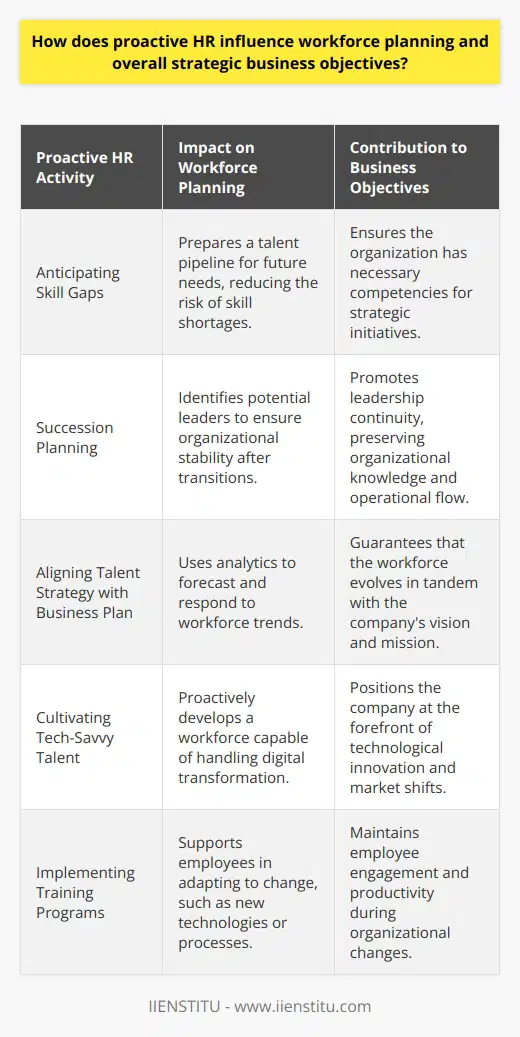
What are the best practices for incorporating proactive HR approaches into an organization's workplace culture and policies?
Reinforcing Workplace Culture through Proactive HR Approaches
Adopting proactive Human Resources (HR) practices to reinforce workplace culture and policy significantly influences an organization's productivity and integrity. Implementing such practices necessitate a clear understanding of the organization's vision and objectives. The following are considered best practices.
Communication and Engagement
Effective communication is essential, promoting a two-way exchange of ideas and transparency. Organizations where management nurtures active engagement manifest higher levels of job satisfaction and overall cooperation.
Training and Development
Continuous training and development opportunities not only advance employee skills but also boost morale. Assisting employees in their career growth shows that the organization values their contribution and is invested in their future.
Policy Crafting
Concise and comprehensive policy crafting is a crucial proactive HR approach. Guidelines should be clearly communicated and document to minimize ambiguity. This can streamline decision-making and create an organized and disciplined workplace.
Emphasis on Diversity and Inclusion
Current HR best practices underscore the importance of diversity and inclusion. A diverse workforce promotes a myriad of perspectives, enhancing innovation and problem-solving. Therefore, HR practices must nurture an inclusive environment where every employee feels valued and respected.
Implementation of Technology
The use of cutting-edge HR technology can simplify processes, improve efficiency, and enhance data accuracy. Advanced HR tech, like human resource management systems (HRMS), can manage many HR tasks, developing a well-organized and efficient HR department.
Use of Employee Surveys
On-going employee surveys provide a quantifiable measure of employee satisfaction and engagement. They serve as a tool for receiving feedback in real-time and identifying areas of improvement.
Taking a proactive rather than reactive approach in HR brings multiple benefits. Regularly examining and adjusting HR practices to align with business goals and values can create a productive and harmonious workplace culture, ultimately driving organizational success.
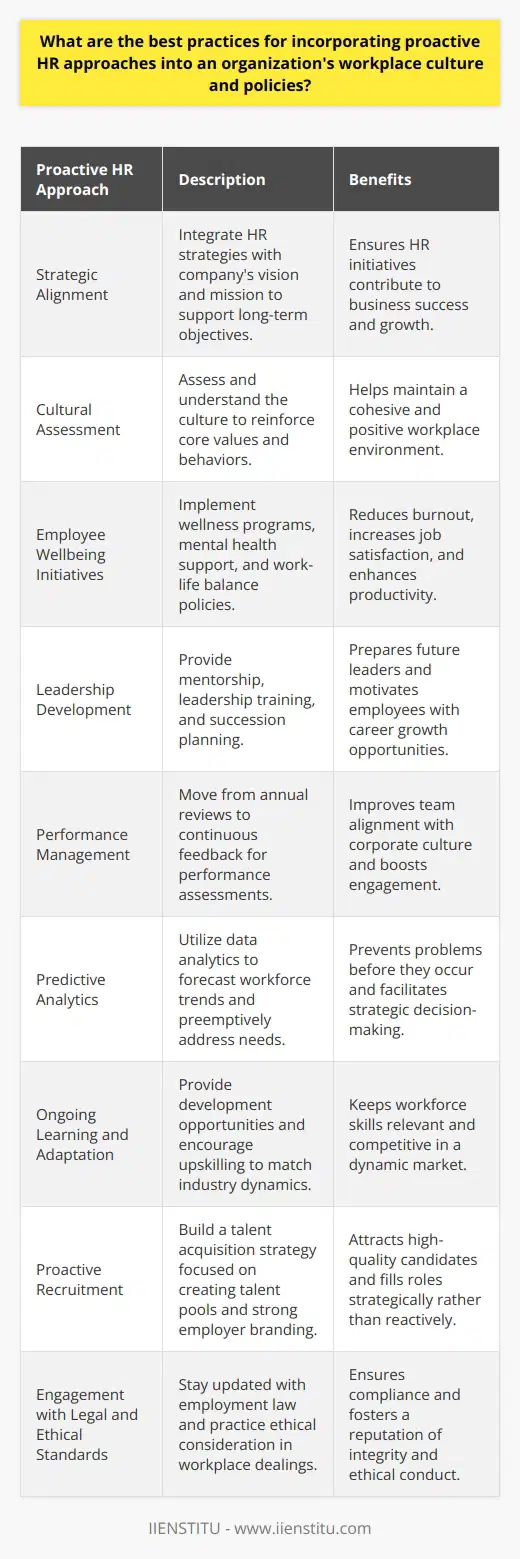
What are the key factors that contribute to the development and integration of a proactive HR approach within an organization?
Organizational Culture and Leadership
The development of a proactive HR approach within an organization heavily depends on its prevailing culture and leadership approach. A culture that champions innovation, risk-taking, and continuous improvement often encourages a proactive HR approach. Leaders who demonstrate open-mindedness and embrace change serve as potent catalysts to HR proactivity.
Strategic Alignment
Moreover, alignment of HR strategies with the overall organizational objectives contributes significantly to a proactive HR approach. When HR works towards achieving long-term goals, they become more strategic and proactive. This necessitates understanding the business model, market trends, and competitive landscape to effectively align HR activities.
People Analytics
Effective use of people analytics is another key factor. Accurate and timely data aids in proactive decision-making. Utilizing data-driven insights, HR can anticipate and prepare for future challenges. This helps minimize reactive measures and fosters a proactive culture.
Employee Engagement
Employee engagement also plays a vital role in fostering a proactive HR approach. Engaged employees willingly contribute their best efforts, ideas, and insights for organizational success. Building an open, collaborative environment supports proactive engagement strategies, thus propelling HR proactivity.
Capabilities and Skills of HR Professionals
Lastly, the capabilities and skills of HR professionals themselves play a pivotal role in the movement towards proactivity. HR professionals need to be able to adopt a strategic mindset, adapt to change, and exhibit leadership competencies. By developing these skills, they can foster proactivity, allowing the HR department to anticipate and meet the emerging needs of the organization.
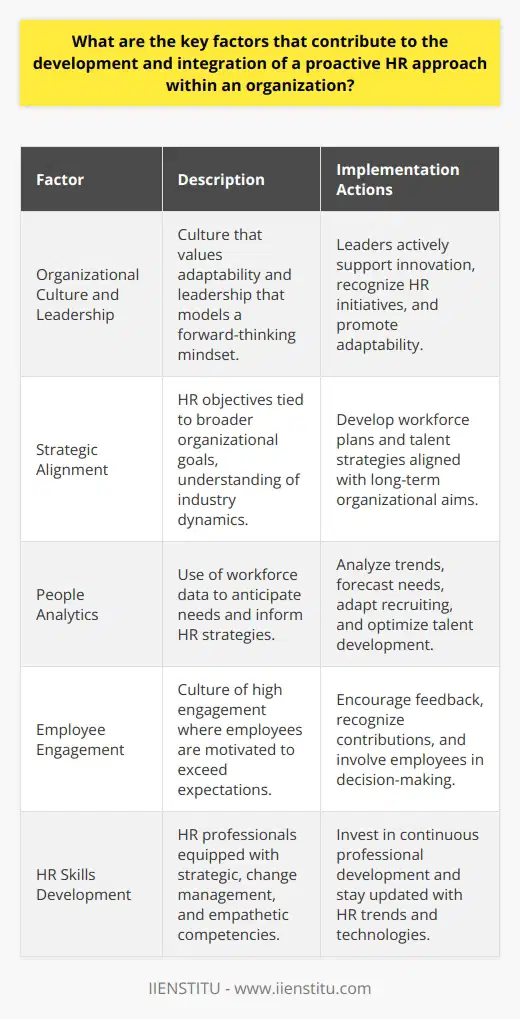
How does adopting a proactive HR approach impact the overall employee experience and contribute to a positive organizational culture?
Impact on Employee Experience
Adopting a proactive HR approach significantly enhances the overall employee experience. It fosters a work environment where employees feel valued, respected, and heard. The process entails anticipating the needs of employees and addressing them promptly, thus reducing potential issues that may arise. When an organization foresee potential challenges, it prepares employees to handle them effectively.
Contribution to Positive Organizational Culture
Active participation of HR in matters of concern to employees builds trust. It promotes open communication, leading to better relationships between staff and management. Moreover, this proactive behavior paves way for a positive culture based on transparency and mutual respect.
The proactive approach of HR includes continuous feedback. It promotes a learning culture in the organisation. This culture values constructive criticism, leading to improved employee performance and enhanced job satisfaction.
Proactive HR policies also include career development programs. Such initiatives foster a culture of lifelong learning, where employees constantly improve their skills. This not only increases their efficiency but also makes them committed to the organisation.
Relevance of Proactive HR Efforts
Combined, these proactive HR efforts craft a cohesive workplace environment. They foster a sense of stability, creating a productive and motivating work atmosphere. The work atmosphere influences the morale and motivation of its employees thus boosting productivity.
In conclusion, adopting a proactive HR approach significantly improves the overall employee experience and contributes to a positive organisational culture. The approach creates a supportive environment where employees can effectively contribute to the achievement of organizational objectives. This in turn leads to the success and growth of the organisation.
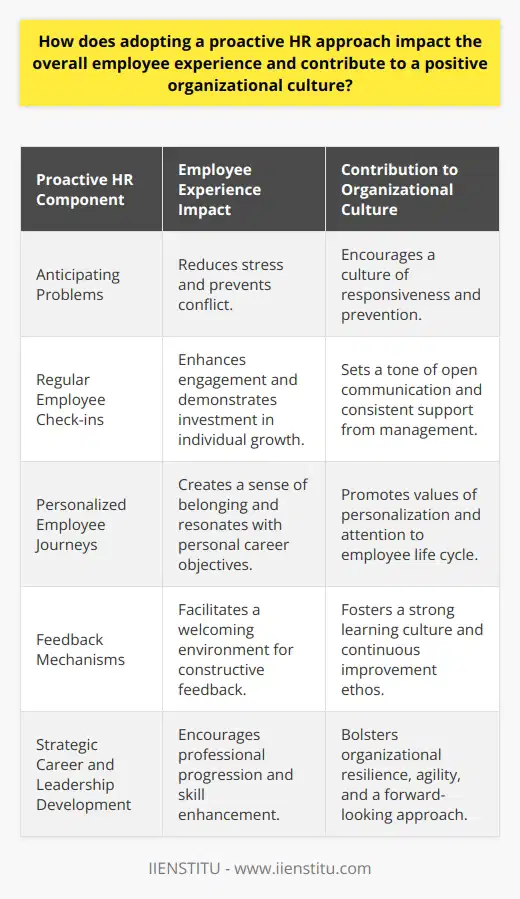
In what ways can proactive HR practices and methodologies support an organization's talent management and succession planning strategies?
Proactive HR Practices and Their Impact
Proactive HR practices influence talent management and succession planning through several key areas.
Talent Identification and Retention
Firstly, HR practices play a vital role in identifying and retaining talent. Proactive HR methodologies, which may include advanced data analytics, can help in pinpointing high-performing personnel and resonating measures to retain them.
Talent Development
Moreover, proactive HR procedures provide room for talent development. These might involve structured training programs, mentoring opportunities, and professional development plans, nurturing employees for future roles.
Succession Planning
Subsequently, succession planning is effective when HR practices allow seamless transition to future leaders. HR can formulate guidelines to select future leaders from a pool of high-potential employees early on and groom them for potential roles.
Promoting Organizational Culture
Proactive HR methods also promote a robust organizational culture. They act as a bridge between management and employees and foster engagement, which contributes to talent management.
Workforce Planning
Workforce planning is another area where proactive HR strategies are instrumental. HR methods like forecasting future staffing needs and designing a comprehensive strategy to meet those needs boost succession planning.
Performance Management
Lastly, effective performance management is a cornerstone of proactive HR practices. Regular appraisal systems and reward programs help motivate employees, thereby facilitating talent retention.
Summarily, proactive HR practices are indispensable for an organization's talent management and succession planning strategies. They provide an integrated approach encompassing talent identification, development, and retention alongside thorough succession planning. By so doing, they ensure the continuity of leadership and enhance an organization's ability to achieve its strategic goals.
